APOLLO BAY RECREATION RESERVE MASTERPLAN ISSUES AND OPPORTUNITIES

Apollo Bay Recreation Reserve Issues and Opportunities Paper Page 1 20 23
PAPER
We acknowledge and respect the separate and distinct Eastern Maar and Wadawurrung Peoples as the Traditional Owners of the Great Ocean Road’s land, waters, seas and skies and acknowledge their cultural knowledge that has led to sustainable practices and has cared for Country over tens of thousands of years.
We honour Elders past and present and express gratitude for their sharing of wisdom that has ensured the continuation of Culture and Traditional practices.
We are committed to genuinely partner and meaningfully build relationships that reflect self-determination and enable us to work together with Traditional Owners and Aboriginal communities to support the protection of Country, the maintenance of spiritual and cultural practices, and together deliver on their broader aspirations in the 21st century and beyond.
Page 2 Apollo Bay Recreation Reserve Issues and Opportunities Paper
Integrated Site Design Pty Ltd 3/181–183 River Street BALLINA NSW 2478 Tel: 02 6686 5290 Email: admin@integratedsitedesign.com.au Web: www.integratedsitedesign.com.au Disclaimer: This report has been prepared by Integrated Site Design Pty Ltd for the Great Ocean Road Coast and Parks Authority and may only be used and relied on by the Great Ocean Road Coast and Parks Authority for the purpose agreed between Integrated Site Design Pty Ltd and the Great Ocean Road Coast and Parks Authority. This report may not be copied, disclosed or distributed outside the Great Ocean Road Coast and Parks Authority in any manner without the express written authorisation of Integrated Site Design Pty Ltd. Integrated Site Design Pty Ltd otherwise disclaims responsibility to any person other than the Great Ocean Road Coast and Parks Authority arising in connection with this report. Integrated Site Design Pty Ltd also excludes implied warranties and conditions, to the extent legally permissible. Drawings, figures, analysis, forecasts and other details in this report have been prepared in good faith based on data and information supplied to Integrated Site Design Pty Ltd by others. The data is believed to be correct at the time of publication of this report. However, it is noted that predictions, forecasts and calculations are subject to assumptions which may or may not turn out to be accurate. Integrated Site Design Pty Ltd expressly disclaims all and any liability to any person or persons in reliance on the report and its contents in part or in whole.
ACKNOWLEDGEMENT OF COUNTRY
1 INTRODUCTION
APOLLO BAY RECREATION RESERVE
PURPOSE OF THE ISSUES AND OPPORTUNITIES PAPER
DEVELOPMENT OF A MASTERPLAN FOR THE RESERVE
PROJECT PROCESS
COMMUNITY AND STAKEHOLDER CONSULTATION
APOLLO BAY P-12 COLLEGE
2 THE SITE
LAND MANAGERS
CURRENT SITE CONDITIONS
CAMPGROUND PRECINCT
CAMPING UPLIFT PROJECT
CHANGING PLACES FACILITY
UPPER RESERVE PRECINCT FOR CAMPING
PUBLIC RECREATION PRECINCT
VEGETATED EMBANKMENT
UPPER RESERVE PRECINCT
PONY CLUB PRECINCT
FIRE SAFETY COMPLIANCE
3 INFLEUNCING STRATEGIES AND LEGISLATION
2018 GREAT OCEAN ROAD ACTION PLAN
COMMUNITY INFRASTRUCTURE PLAN (CIP)
COMMUNITY INFRASTRUCTURE ASSESSMENT
COLAC OTWAY SHIRE COUNCIL OPEN SPACE STRATEGY
CORANGAMITE REGIONAL FLOODPLAIN
MANAGEMENT STRATEGY 2018-2028
BIODIVERSITY ASSESSMENT
GREAT OCEAN ROAD ENVIRONS AND PROTECTION ACT
2020
CROWN LAND (RESERVES) ACT 1978
CROWN LAND CARAVAN PARKS POLICY UPDATE 2019
MARINE AND COASTAL ACT 2018
MARINE AND COASTAL POLICY
MARINE AND COASTAL STRATEGY
EMERGENCY MANAGEMENT PLAN (EMP)
COMMERCIAL REVIEW
COLAC OTWAY PLANNING SCHEME
4 ISSUES AND OPPORTUNITIES ISSUES
RIVERINE FLOODING RISK
RIVERINE AND COASTAL HAZARD RISK MANAGEMENT –NOW AND IN THE FUTURE
ANNUAL PERMIT SITES AND FIXED ACCOMMODATION –COMPLIANCE, RISK AND SAFETY, AND EQUITY
CONDITIONS AND COMPLIANCE ISSUES
OTHER FIXED ACCOMMODATION
POLICY CONSIDERATIONS – EQUITY AND FAIRNESS
SUPPORTING EXISTING REGISTERED RESIDENTS
SPORTING AND RECREATIONAL USE
FUTURE SPORTING FACILITY MANAGEMENT
CAR PARKING
INDUSTRIAL HALL
PONY CLUB SITE
STORAGE FOR OTHER USER GROUPS
OPPORTUNITIES
SPORTING FACILITIES EXPANDED TO MEET CURRENT AND FUTURE REQUIREMENTS
PUBLIC USE AND AMENITY
ADDITIONAL AREAS FOR COMMUNITY EVENTS AND ACTIVITIES
CAMPGROUND REDESIGN
EXPANDING THE RANGE OF VISITOR
ACCOMMODATION
IMPROVED ACCESS AND EQUITY
SEASONAL WORKER ACCOMMODATION
CAMP AMENITIES REDESIGN
ECOLOGICAL AND CULTURAL HERITAGE IMPORTANCE
5 CONCLUSION AND NEXT STEPS
Apollo Bay Recreation Reserve Issues and Opportunities Paper Page 3
INTRODUCTION

INTRODUCTION
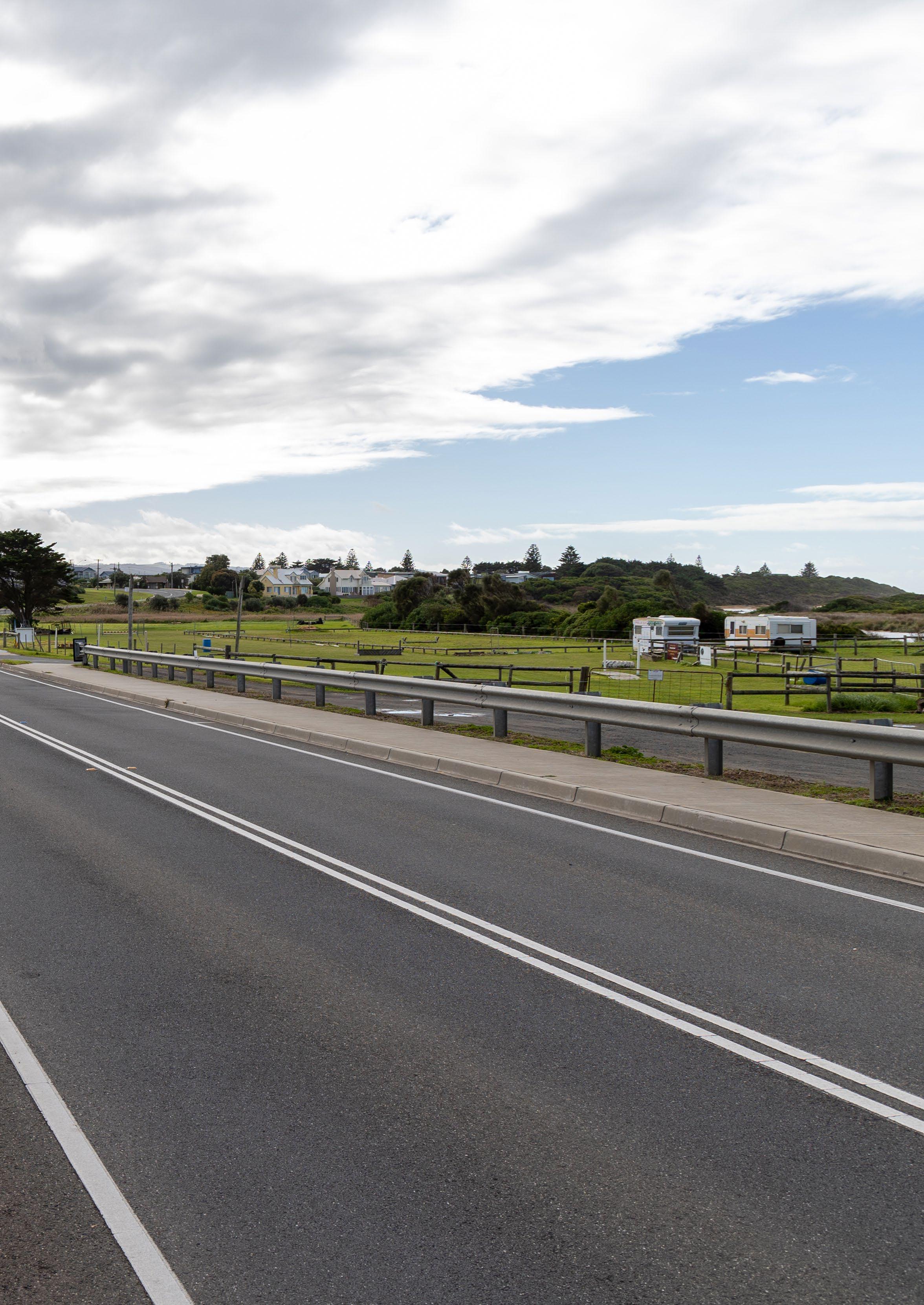
Apollo Bay Recreation Reserve May 2023
APOLLO BAY RECREATION RESERVE
Located on the southern fringe of the Apollo Bay township, the Apollo Bay Recreation Reserve (the Reserve) represents an important site for passive and active recreation. The Reserve is an important community space and is the primary location for the provision of sporting facilities for Apollo Bay and nearby townships such as Marengo and Skenes Creek. The Reserve has also provided camping and accommodation for visitors and tourists to the region for over 80 years, providing a central location to explore the township and coastline.

Page 6 Apollo Bay Recreation Reserve Issues and Opportunities Paper
PURPOSE OF THE ISSUES AND OPPORTUNITIES PAPER
This Issues and Opportunities Paper (the Paper) has been prepared to identify the context, issues, processes, challenges and opportunities that will shape the Apollo Bay Recreation Reserve Masterplan. Specifically, it aims to:
• Consolidate a broad range of existing and new information to inform land use and development objectives
• Identify the key state and local policy provisions, programs and strategies that affect the study area
• Identify the key technical issues that affect the study area
• Gain an understanding of the community’s needs and aspirations
• Identify and analyse the site’s key constraints and opportunities
• Identify any conflicting issues requiring resolution
• Identify information gaps, where applicable; and
• Provide direction and recommendations for the draft Masterplan.
This report should be read in conjunction with the draft Masterplan.
DEVELOPMENT OF A MASTERPLAN FOR THE RESERVE
The Masterplan will guide the future land use and development of the Reserve to achieve identified outcomes for the local community, visitors to the region, the environment and Traditional Owners. The Masterplan will also acknowledge and address the site’s significant underinvestment and lack of a shared vision. Importantly, actions that preserve the site’s unique character and values, whilst addressing key issues and opportunities, will be identified.
The Masterplan will reflect community aspirations and address the following desired outcomes:
• Provide clear and achievable deliverables and recommendations to guide the management, use and appropriate development of the Reserve
• Cater for sporting clubs and community use including events
• Cater for a more diverse group of visitors and improved visitor experience
• Develop a concept facilities design for the Reserve with a broad accommodation mix that considers the legislative and policy framework for coastal land, risk from natural hazards
including flooding, cultural heritage values, and site capacity
• Protect the environmental values of the Reserve and consider the impacts of climate change, and
• Cater for demand and trends in the context of the Great Ocean Road Coast and Parks Authority’s (the Authority) responsibilities over the next ten years (guiding sustainable tourism, enhancing the visitor experience, and supporting local employment).
Apollo Bay Recreation Reserve Issues and Opportunities Paper Page 7
PROJECT PROCESS
The Issues and Opportunities Paper and draft Masterplan have been developed across a number of Phases outlined below.
PHASE 1
ISSUES AND OPPORTUNITIES PAPER
COMMUNITY AND KEY STAKEHOLDER INPUT
WE ARE HERE
PHASE 2
DRAFT MASTERPLAN
PHASE 3
FINAL MASTERPLAN
Page 8 Apollo Bay Recreation Reserve Issues and Opportunities Paper
MASTERPLAN PHASE 1
Phase 1 Consultation
The purpose of Stage 1 Consultation was to understand, discuss and confirm the existing opportunities and issues at the Reserve.
Issues and Opportunities Paper
An Issues and Opportunities Paper was prepared as part of Phase 1 to identify and understand the context, issues and opportunities present at the Apollo Bay Recreation Reserve. This Paper guided the preparation of the draft Masterplan and was informed by community and stakeholder feedback, the identified constraints of the land, specialist technical studies, and state and local policies and projects. This Paper should be read in conjunction with the Masterplan to provide additional contextual information.
MASTERPLAN PHASE 2
Draft Masterplan
A draft Masterplan has been developed to guide future land use and development of the Reserve to achieve identified outcomes for the local community, visitors to the region, the environment and Traditional Owners.
Informed by information collated throughout the Issues and Opportunities Paper process, the draft Masterplan outlines a vision for the Reserve and four guiding principles that ensure future land use is consistent with the community’s aspirations and the protection of environmental and cultural values.
Phase 2 Consultation
The purpose of the consultation is to seek feedback on the draft Masterplan from various stakeholders, the broader community and Traditional Owners. The Issues and Opportunities Paper gives context to the readers of the draft Masterplan providing additional information as to why certain actions and approaches have been taken.
Apollo Bay Recreation Reserve Issues and Opportunities Paper Page 9
COMMUNITY AND STAKEHOLDER CONSULTATION
During May and June 2022, consultation was undertaken with the local Apollo Bay community and key stakeholders in relation to the preparation of a Masterplan for the Apollo Bay Recreation Reserve. Input was sought through community events, key stakeholder meetings and an online survey. The purpose of these activities was to create a platform to engage with the broader community on issues impacting the Reserve, seek their input on what is important to them and identify options to address those issues.

Face to face meetings were held with representatives of the Apollo Bay Football Netball Club, Apollo Bay Cricket Club, Apollo Bay Tennis Club, the Apollo Bay and Otway Riding Club and Pony Club.
A representative of Colac Otway Shire Council also attended the meetings and provided specialist advice on the provision of sporting facilities and the funding available from government agencies. Online meetings were held with the Apollo Bay Chamber of Commerce and a representative of the Apollo Bay Agricultural Society. Contact was also made with the local emergency service providers, including the Apollo Bay Police, Ambulance and Country Fire Authority (CFA).
Through the community events, more than 200 ‘Have your Say’ postcards were distributed directing people to the online survey, with Authority staff speaking to approximately 200 people. The Apollo Bay community were enthusiastic to be involved and displayed a passionate interest in the future of the Reserve.
Page 10 Apollo Bay Recreation Reserve Issues and Opportunities Paper
Sketch design of the clubrooms by the football club
The key feedback from the consultation to date includes:
• Local residents clearly expressed the importance to the community of the Apollo Bay Recreation Reserve and its sporting and cultural identity
• The community rated all aspects of the Reserve with equal priority – caravan and camping facilities, sporting and recreational facilities, protection of natural values, functionality and access
• The community is generally supportive of the caravan park improvements (which they deemed much needed); however, there is a degree of conjecture towards the introduction of new sites and glamping tents
• There is a clear indication that more accommodation should be made available for seasonal workers. This is supported by the Apollo Bay Chamber of Commerce
• Sporting groups identified the need to upgrade current facilities to provide much needed storage space and to bring the changerooms and toilets up to required standards. The netball/tennis courts and cricket nets need to be reconfigured to conform to standards. The football club provided a draft design for the extension and upgrade of the current clubroom and changerooms (see image on the previous page)
• The Apollo Bay Sailing Club is seeking the inclusion of storage facilities for their safety boats, which are currently stored on private property, but the club has no long-term tenure
• Consideration should be given to appointing a Committee of Management to oversee the sport and recreation part of the facility
• The sporting clubs stressed the importance of maintaining on-reserve parking, perimeter parking for football, and future-proofing capability by restricting camping spots
• The Pony Club highlighted the importance of safe and adequate parking at the current location, exiting the Great Ocean Road. The club suffers from a lack of facilities and poor fencing and fields
• The sporting clubs raised issues in relation to the quality and safety of the playground. There were concerns that children using the playground are unable to be supervised by parents watching sport because of structures blocking the view corridor
• Emergency services and disability access needs to be maintained
• The community raised the possibility of a skate park within the Reserve if it is to be relocated from its current location on the Apollo Bay Foreshore Reserve at the end of its useful life
• During consultation with user groups, the importance of the Agricultural Show to the local community was repeatedly mentioned. Apart from the benefits to the community, the Agricultural Show Society identified the show as a major source of fundraising for the Society.
Apollo Bay Recreation Reserve Issues and Opportunities Paper Page 11

A campsite at the Recreation Reserve
APOLLO BAY P-12 COLLEGE
As part of the consultation process, contact was made with the local school to determine whether there has been an increasing number of families moving to the area following the impact of COVID-19. Increasing numbers of students attending schools provides a strong indication of the future trending
of sporting participants. The increasing number of students attending the school will result in an increased demand for sporting facilities over future years, placing additional pressure on the limited area currently provided.
APOLLO BAY P-12 FULL-TIME EQUIVALENT STUDENTS

Apollo Bay Recreation Reserve Issues and Opportunities Paper Page 13
2019 272 2020 290 2021 296 2022 300
THE
The Apollo Bay Recreation Reserve is located at 70 Great Ocean Drive, Apollo Bay. The Reserve is approximately 8.5 hectares in area, with frontage to the Great Ocean Road to the east, the Barham River to the south and west, and Gambier Street to the north.

The Apollo Bay and Otway Riding Club and Apollo Bay Pony Clubs occupy approximately 1.2 hectares of land on the eastern side of the Great Ocean Road, which is also part of the study area. The project site, in the context of the broader Apollo Bay area, is shown in the image below.

The area includes three Crown land parcels. The land parcels and Crown Reserve purpose are shown in the table on the following page, with the image above illustrating the extent of each of the Crown allotments. Crown Allotment 11B Section 1, currently used by the Pony Club, is identified as coastal Crown land. The remaining two allotments were excised from the coastal Crown land estate.
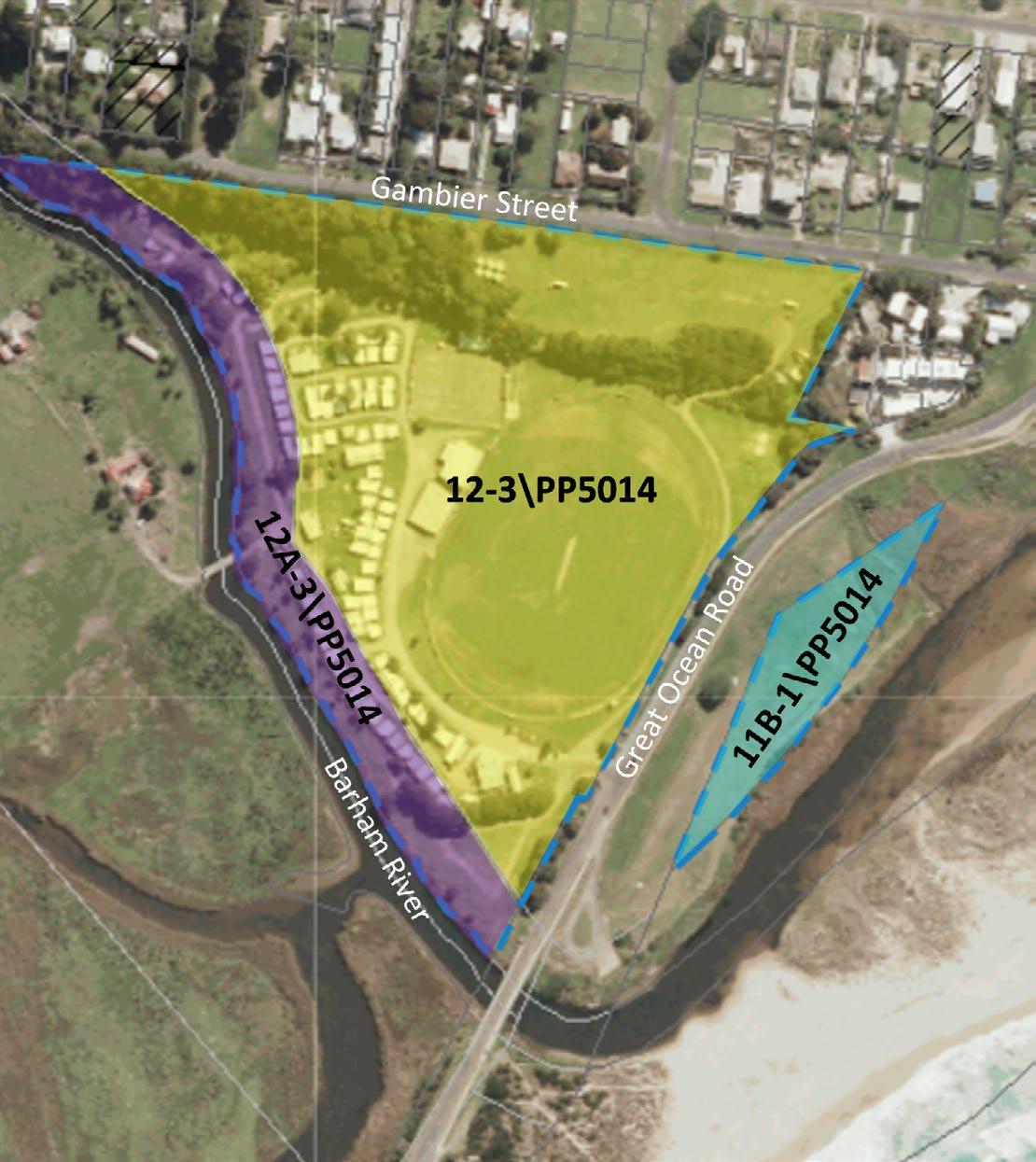
SITE
LOT/PLAN OR CROWN
Crown Allotment 11B Section 1
RESERVE PURPOSE
Reservation MI242995M –
Temporary cricket and other purposes of public recreation
Crown Allotment 12A Section 3
12-3\PP5014
Reservation MI243004C –Permanent public purposes
Crown Allotment 12 Section 3
12A-3\PP5014
Reservation MI243007V –
Temporary cricket and other purposes of public recreation

DESCRIPTION
SPI
11B-1\PP5014
LAND MANAGERS
In 1868 the site was set aside as Crown land. While the land was subsequently offered as private land for farming, this offer was not taken up and the site was not formally allocated to private land ownership.
The Reserve remains as part of the Crown land estate and has had numerous delegated land managers over its life.
In 2020, the Authority became land managers of the Reserve. As part of a restructure and simplification of the fragmented coastal land managers along the Great Ocean Road, the Authority was established as the dedicated land manager to deliver better protection and management of the region’s iconic coasts and parks. In the Apollo Bay region, the former Otways Coast Committee transitioned into the newly formed Authority.
In partnership with the Traditional Owners, the role of the Authority is to manage, protect and foster resilience of the natural, cultural and heritage values of coastal Crown land and marine waters along the Great Ocean Road.
This includes:
• Guiding sustainable tourism, supporting local employment, and enhancing the visitor experience
• Strengthening the protection of land and seascapes from the impacts of climate change
• Improving economic development for a prosperous and liveable region.
• All activity is in line with their guiding principles that ensure all economic, social, environmental, and cultural concerns are considered in a balanced and sensitive way.
As a public land manager for the Great Ocean Road coast and parks, the Authority manages a wide variety of public land from National Parks to coastal beaches and town foreshores.
All revenue raised through their commercial endeavours is reinvested back into the coast to ensure the Great Ocean Road region can be enjoyed now and for generations to come.

Page 16 Apollo Bay Recreation Reserve Issues and Opportunities Paper
CURRENT SITE CONDITIONS
The current facilities at the Apollo Bay Recreation Reserve cater for a wide variety of community and visitor uses.
The site can be described as comprising two distinct areas, separated by a steep vegetated embankment. The lower, flatter area by the river includes most of the campground facilities and sporting facilities. An elevated area adjacent to Gambier Street has a cleared area that was previously used for overflow camping during peak periods, a pedestrian access track that leads to the main town centre, and a vegetated area of native lowland forest including koala habitat.
For the purpose of this report, the two distinct areas have been further refined to five precincts based on predominant activities; Campground precinct,

Public recreation precinct, Vegetated embankment, Upper Reserve precinct and Pony Club precinct. The various precincts provide specific facilities, but there is significant overlap and sometimes conflicting use between them. This section aims to highlight specific issues, culminating in the identification of emerging common issues.
There has been minimal investment in the campground and sporting facility assets over an extended period, with many assets now degraded and in need of significant repairs and/or replacement.
Apollo Bay Recreation Reserve Issues and Opportunities Paper Page 17
The image on the following page illustrates the five precincts within the Reserve.

Page 18 Apollo Bay Recreation Reserve Issues and Opportunities Paper

Apollo Bay Recreation Reserve Issues and Opportunities Paper Page 19
CAMPGROUND PRECINCT

The campground precinct is managed and staffed by the Authority and is located on the southern and western sides of the central access road, with approximately 500 metres of frontage to the Barham River. The campground precinct occupies approximately three hectares of level land, which has been identified and mapped by the Corangamite Catchment Management Authority (CCMA) as subject to inundation from riverine flooding (see page 55 Riverine Flooding Risk). There is only one formal, sealed vehicle access point from the Great Ocean Road into the Reserve, and it is shared between the campground and all other public recreation facilities. There is an unsealed vehicle access track north of the sports oval that connects to Gambier Street.
The campground provides tourist cabins, camp sites and annual permit sites. There are three sites occupied by registered residents who each hold a two-year
permit. Five older style cabins, currently used by Authority employees, are also located in this area.
A park office building is located at the entry with a caretaker’s residence adjacent. There are three amenity buildings, one near the park entry, one in the central area and another servicing the northern sites. A small camp kitchen building is located in the central area. The communal buildings are primarily used by campground guests, but also by users of the recreation precinct during match days and other events. The Department of Environment, Land, Water and Planning (now the Department of Energy, Environment and Climate Action – DEECA) previously conducted an asset condition rating on all assets at the Reserve on behalf of the former public land managers. The condition of the assets is variable, with many containing significant defects.
Page 20 Apollo Bay Recreation Reserve Issues and Opportunities Paper
The Industrial Hall is located in the central area, behind the clubroom building. The hall is used by the Authority for storage of plant and equipment to maintain the Reserve. The hall is also used by the football and netball clubs and the Agricultural Society to store annual show material. The building was traditionally used for an annual show, which has recommenced following COVID-19.

The visitor sites are level and reasonably sized, comprising powered and unpowered sites (see breakdown on the following page). About one-third of the unpowered sites are located on the banks of the Barham River.
There are 36 registered annual permit sites in the park, with a wide range of van and annexe combinations located on these sites. The owners of the caravans are required to pay an annual fee for the use of the annual permit site, and in return they are permitted to stay in their van for up to 59 consecutive nights and 180 days over the permit period. These sites are not intended to be used on a permanent basis as a residential dwelling, and permits were not intended to provide guaranteed, multi year access to existing permit holders.
The option of annual permits was introduced many years ago to provide a guaranteed source of income for park owners, while allowing caravan owners to store their van on the site to use for a limited number of days per year. Over recent years, the number of these permits has diminished as demand for tourist sites continues to rise with higher numbers of travellers and increasing caravan sales.
To address the growing demand for access to Crown land caravan parks, the Improving Equity of Access to Crown Land Caravan and Camping Parks 2011 Policy Statement was released by the Victorian Government. It aimed to give all Victorians access to the affordable holiday opportunities the parks offer. It also aimed to boost tourism opportunities and local economies by providing more short-term access to sites in these parks.
The structures on the annual permit sites at the Reserve are of variable age and condition, but the overall effect diminishes the visual amenity of the park, reduces its appeal for visiting tourists and does not meet current legislative requirements.
Apollo Bay Recreation Reserve Issues and Opportunities Paper Page 21
The Industrial Hall

The campground comprises a total of 187 sites as listed below:

• 8 tourist cabins (6 currently used for staff accommodation and 2 used for offices)
• 49 powered sites (plus five old annual sites used at peak times)
• 36 annual permit sites currently in use
• 45 riverside unpowered sites
• 37 other unpowered sites
• 11 oval unpowered sites
Page 23
CAMPING UPLIFT PROJECT
The Camping Uplift Project, which is funded through grants from the Department of Jobs, Skills, Industry Regions (DJSIR) and the Department of Energy, Environment and Climate Change (DEECA), commenced stakeholder engagement in 2022. The funding provides ten all-season accessible (Disability Discrimination Act - DDA compliant) ‘glamping’ tents at the Reserve, and a further ten ‘glamping’ tents for other users. These new offerings would sit alongside additional powered and unpowered camp sites, and new amenities such as bathrooms, a camp kitchen and an all-abilities playground.
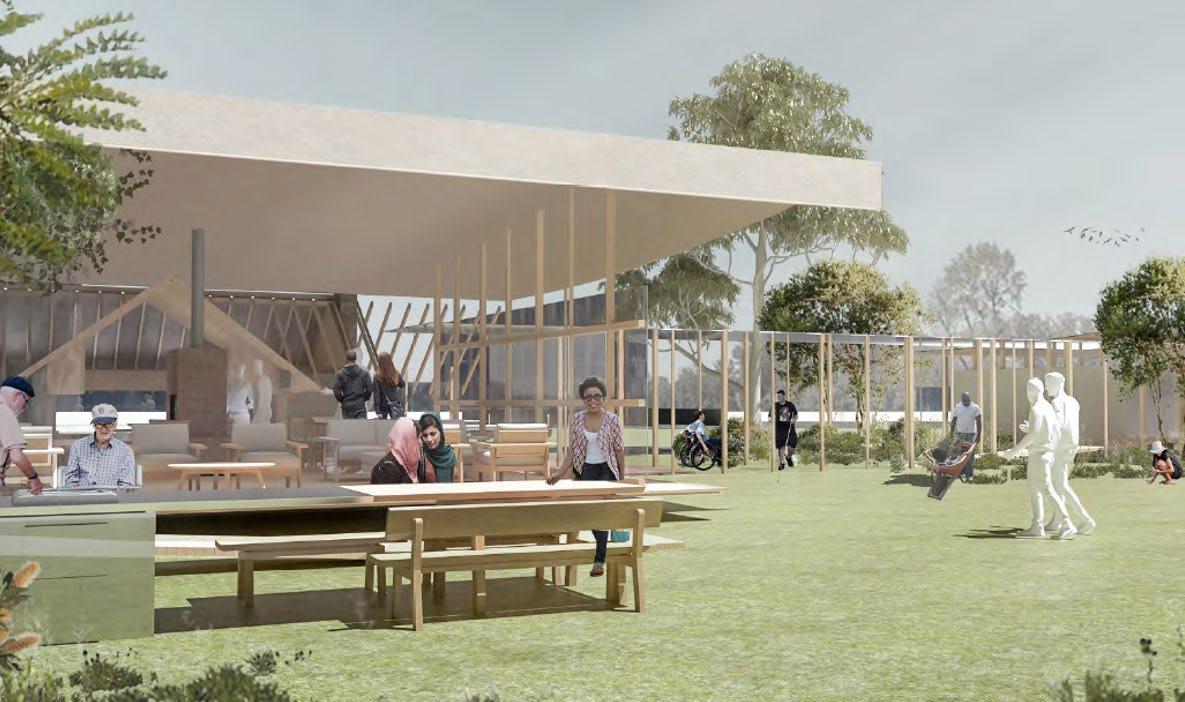
There has been a lack of investment in the maintenance
and upgrade of facilities at the Reserve over a long period, resulting in facilities that are non-compliant in relation to access, and inadequate for the current tourist market (as shown in the pictures on the following pages).
The intention for new amenities was to extend and refurbish the existing buildings. However, an inspection of the buildings has highlighted they are past their useful life, and to extend and refurbish may cost more than installing new demountable (prefabricated) amenity buildings, which would be raised above the flood level, meet all accessibility requirements and be placed in the most suitable location.
Page 24 Apollo Bay Recreation Reserve Issues and Opportunities Paper
The camp kitchen design for the Camping Uplift project
CURRENT SITE CONDITIONS
The existing camp kitchen can be described as a ‘fair weather’ building. While the design presents well, it does not cater for wet and/or windy conditions, and the barbecue facilities are located outdoors making them unable to be used during poor weather. The open design also fails to provide an enclosed gathering space for camping guests during inclement weather, reducing the demand for these sites outside of peak seasons.

Apollo Bay Recreation Reserve Issues and Opportunities Paper Page 25
Existing camp kitchen
Existing central amenities building
Existing northern amenities building


Page 26 Apollo Bay Recreation Reserve Issues and Opportunities Paper
CHANGING PLACES FACILITY
The existing scope of the Camping Uplift project includes provision of a Changing Places facility (toilet and changeroom facilities designed to meet the needs of people with complex disabilities and their carers). However, further consideration is needed to determine if the Reserve is the most appropriate location for this type of facility given the site is at risk from flooding and coastal hazards. Further consideration by stakeholders including Colac Otway Shire Council and funding providers should occur to help inform the best long-term location for the facility.
UPPER RESERVE PRECINCT FOR CAMPING
There was an initial proposal to locate new camping accommodation on the hill in the northern part of the Reserve. However, this would occupy an area previously used for overflow car parking for the annual Agricultural Show and passive open space at other times. The residents along Gambier Street also raised concerns about the re-introduction of camping in this area, particularly in relation to visual, noise and visitor behaviour impacts on their neighbourhood.

Apollo Bay Recreation Reserve Issues and Opportunities Paper Page 27
storage location
Reserve

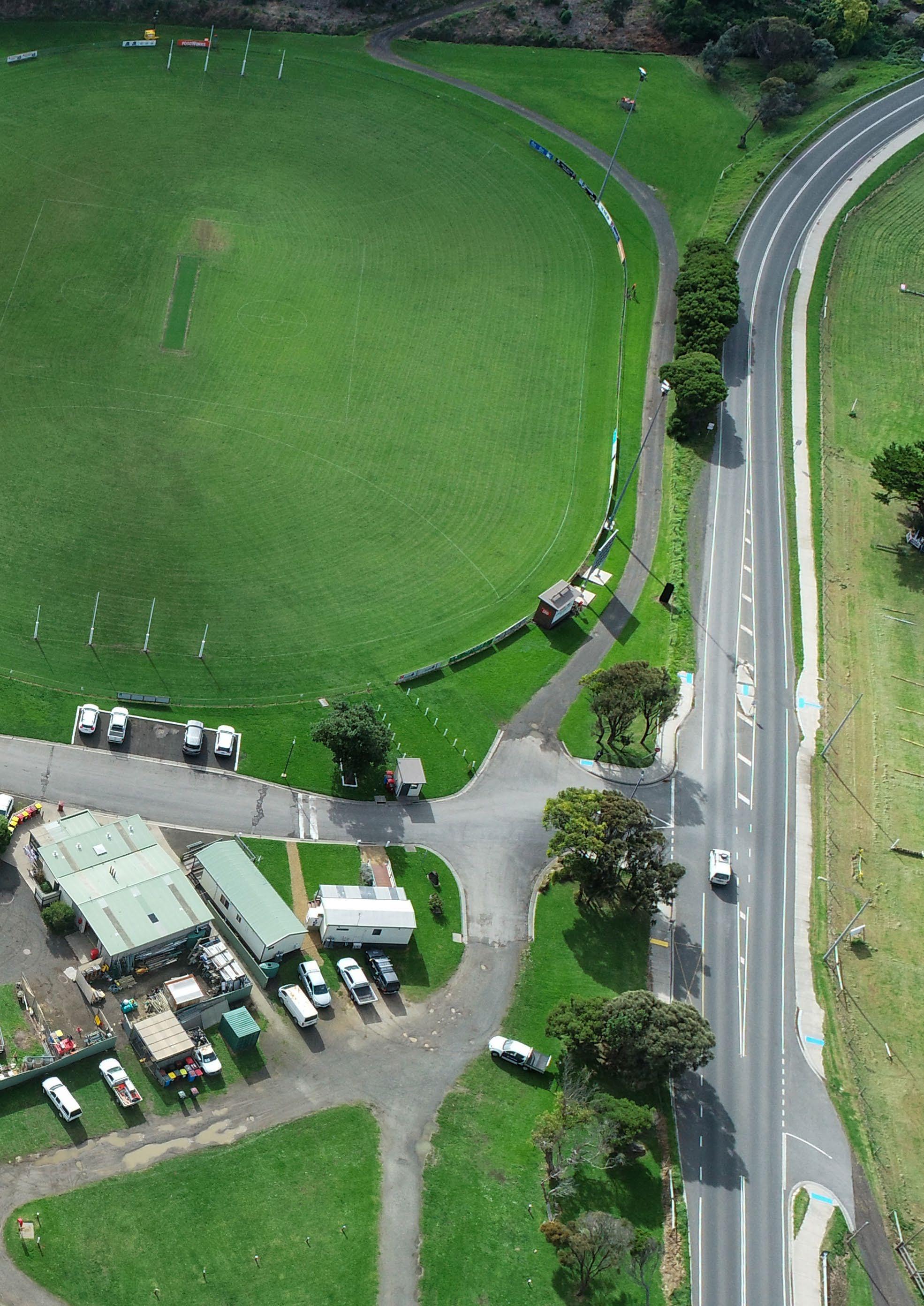
PUBLIC RECREATION PRECINCT

The public recreation precinct is located on the lower Reserve area, north and east of the central access road, with approximately 200 metres of frontage to the Great Ocean Road. The recreation facilities occupy approximately three hectares of level land, which is also mapped as being Land Subject to Inundation. Access to the facilities is via the single vehicle access point from the Great Ocean Road and is shared with the campground precinct.
The recreation grounds are a local town facility and do not cater for regional-level events.
The recreation precinct provides the following facilities:
• Main oval (football and cricket)
• Clubroom and changeroom buildings
• Two cricket practice nets
• Three tennis courts (shared surface with netball courts)
• Two netball courts (shared surface with tennis courts)
• Tennis clubhouse and barbecue shelter
Page 30 Apollo Bay Recreation Reserve Issues and Opportunities Paper
Existing changeroom building (left), clubrooms (right) and the oval
During winter, the Apollo Bay Football Netball Club uses the main field and netball courts, while the Apollo Bay Cricket Club uses the main field and practice nets during summer. The two clubs share the main clubroom building and a separate changeroom building, which also provides public toilets for the Reserve. The Apollo Bay Tennis Club uses the three tennis courts year-round and the small clubhouse and adjacent barbecue shelter.
The public recreation precinct is utilised for a range of sporting activities and is also a hub for many social gatherings for Apollo Bay residents. While the main user groups are football, netball, cricket and tennis, many other groups and individuals also use the recreation facilities. The asset condition of the

facilities is reasonable, but the facility and scale are not meeting the needs of the sporting clubs. The changeroom and clubroom buildings do not cater for all user groups, which limits the activities that can be accommodated. There are no appropriate facilities for female players for either football or netball and current amenities do not meet the requirements for provision of accessible facilities. One additional cricket practice net is also required to meet current needs.
The Reserve is also designated as a backup site for state emergency management operations. The primary site for the DEECA emergency operations centre is the Apollo Bay P-12 College, however the Reserve can act as a backup if needed.
Netball/Tennis Courts


PUBLIC RECREATION PRECINCT cont…

There is insufficient parking for sports participants and spectators during busy sporting periods.
Overflow parking for events and the annual show is included in the Gambier Street precinct. Informal parking around the boundary of the football ground is used as a traditional means of viewing football on cold winter days. There is a general lack of accessible parking to assist people with mobility issues.
The tennis and netball courts use a shared surface with only one sport able to be played at any time.
Safety zones around the edge of the netball courts are also insufficient. The tennis clubhouse needs upgrading and the equipment storage areas throughout the precinct are insufficient.


 BBQ shelter
Clubroom and changeroom parking
Tennis clubhouse Cricket nets
BBQ shelter
Clubroom and changeroom parking
Tennis clubhouse Cricket nets

VEGETATED EMBANKMENT
A vegetated embankment separates the lower area, where most of the facilities are located, from the upper area fronting Gambier Street. A well-used pedestrian track, which connects the lower Reserve with the village, is damaged in several places and needs to be reconstructed. Vegetation on the embankment is in reasonable condition but requires ongoing weed management and restoration. An unsealed vehicle track connects the upper and lower areas of the Reserve. This needs to be stabilised to prevent further deterioration of its surface.


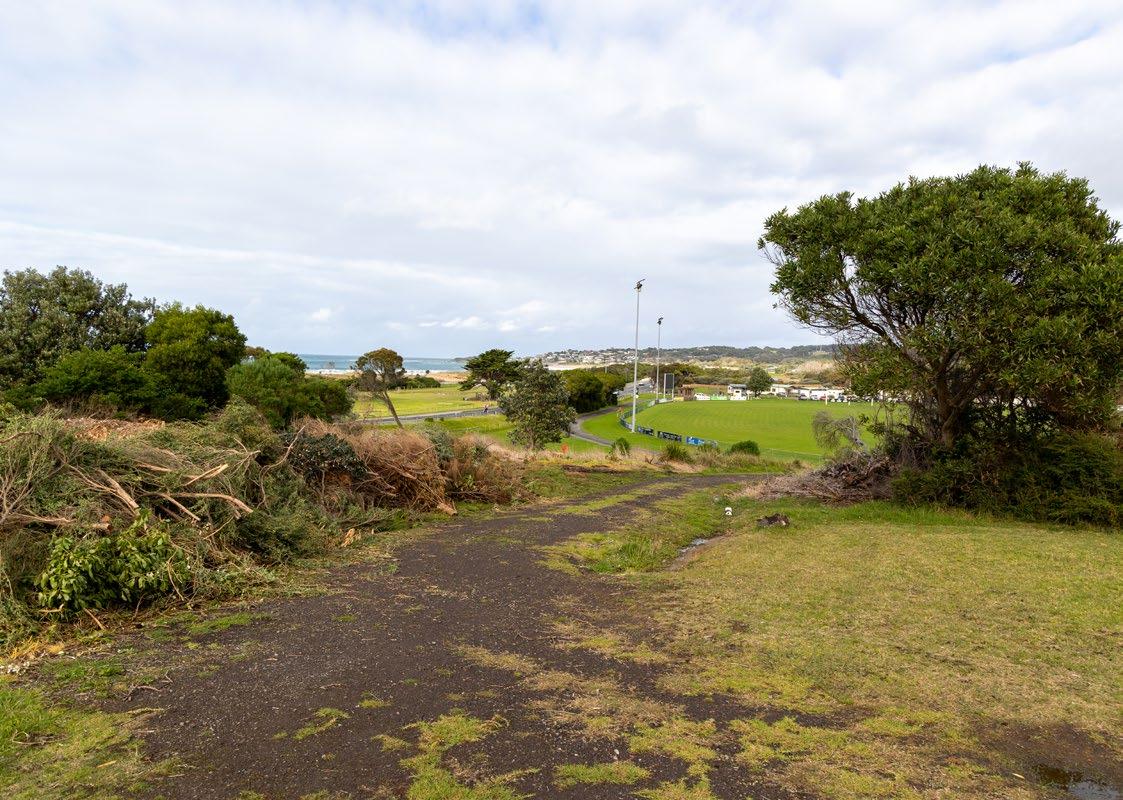
This area is identified by Colac Otway Shire Council as land subject to erosion within the Colac Otway Planning Scheme. The scheme identifies the requirements in relation to permits and specialist reports for any development that may be proposed in this area. The community has identified the protection of flora and fauna in this area and the provision of access to the lower Reserve as key considerations for the Reserve.

Page 36 Apollo Bay Recreation Reserve Issues and Opportunities Paper
Vehicle access track
Embankment above cricket nets
Cleared embankment above oval
Pedestrian track to upper Reserve
UPPER RESERVE PRECINCT
The upper Reserve precinct is a sloping, open grassed area, approximately 0.8 hectares in size with approximately 200 metres of frontage to Gambier Street. It is not flood affected. Access to the upper Reserve precinct is via Gambier Street or by two unsealed tracks from the recreation Reserve below. This precinct contains six water storage tanks at the western end, which supply water to the toilet blocks throughout the Reserve. A walking track through the precinct connects the lower Reserve to the intersection of Cartwright Street and Gambier Street. This is a heavily used pedestrian connection between the village and the Reserve.
The upper Reserve precinct was utilised in the past for camping during peak periods and as an overflow parking area during the Agricultural Society’s annual show. The area generally remains vacant during the remainder of the year. The reintroduction of camping to this area was strongly opposed by the local community as part of the camping uplift project. The precinct is also used by locals as a dog exercise area.
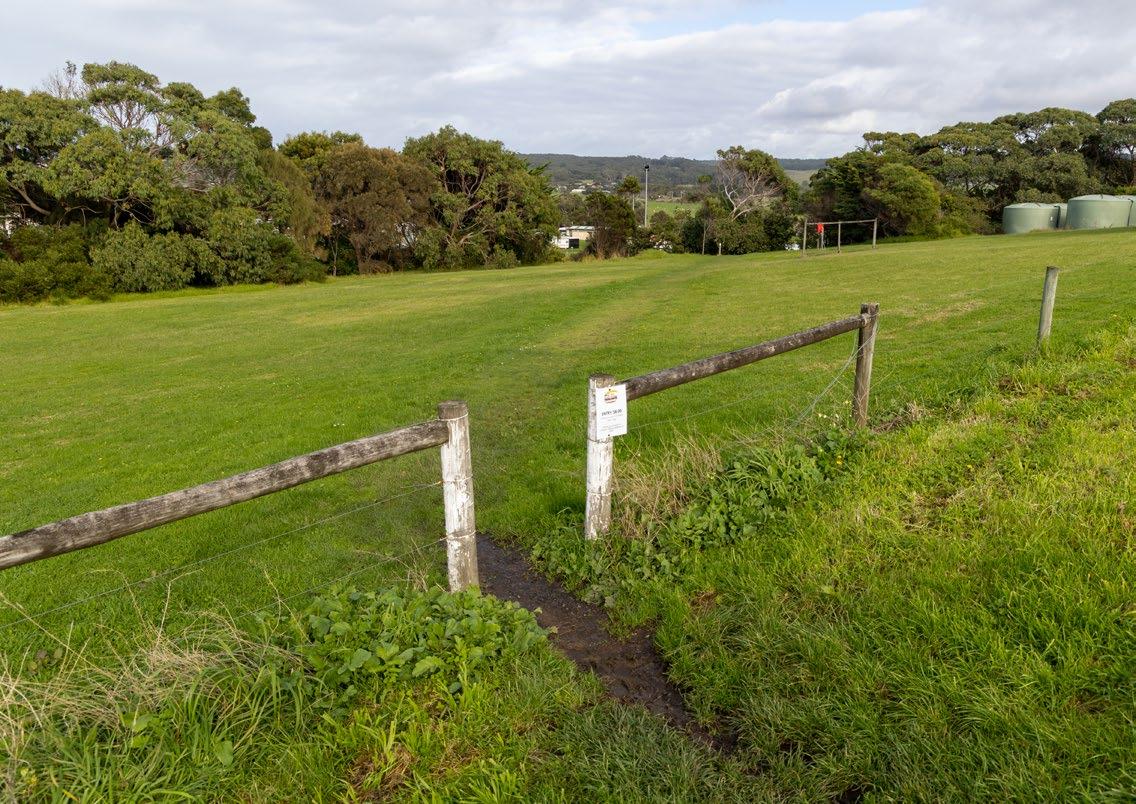
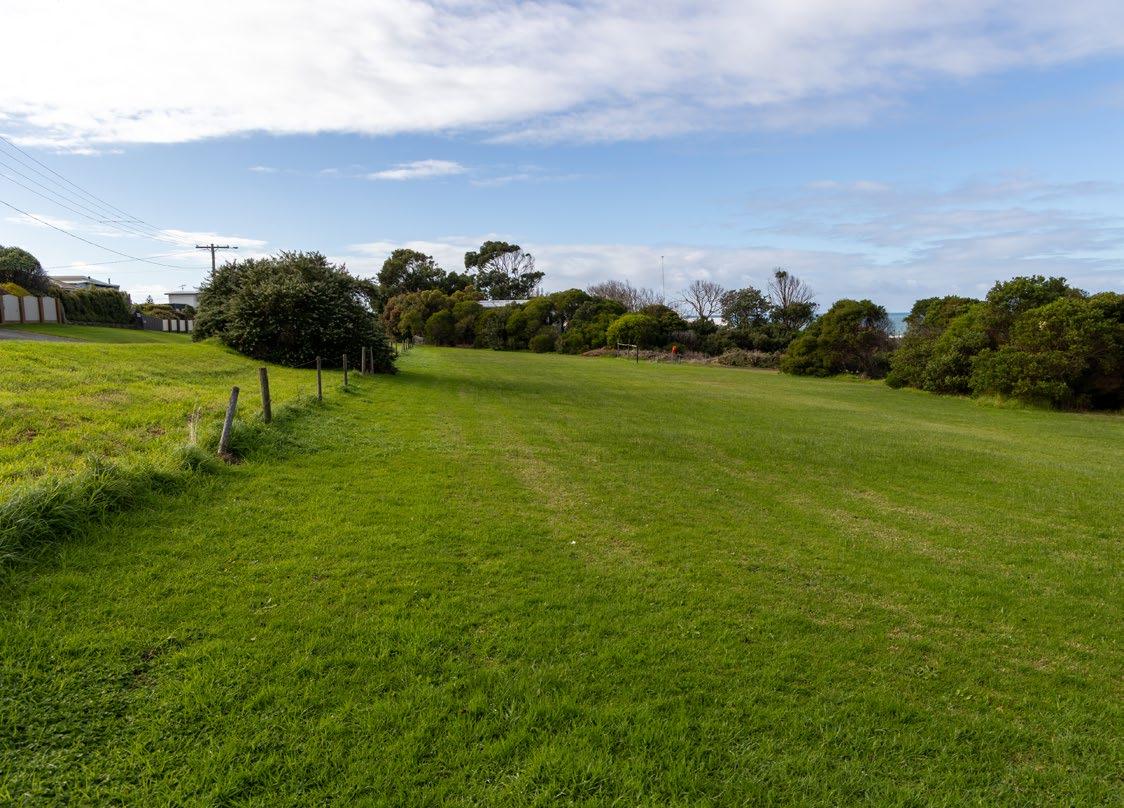
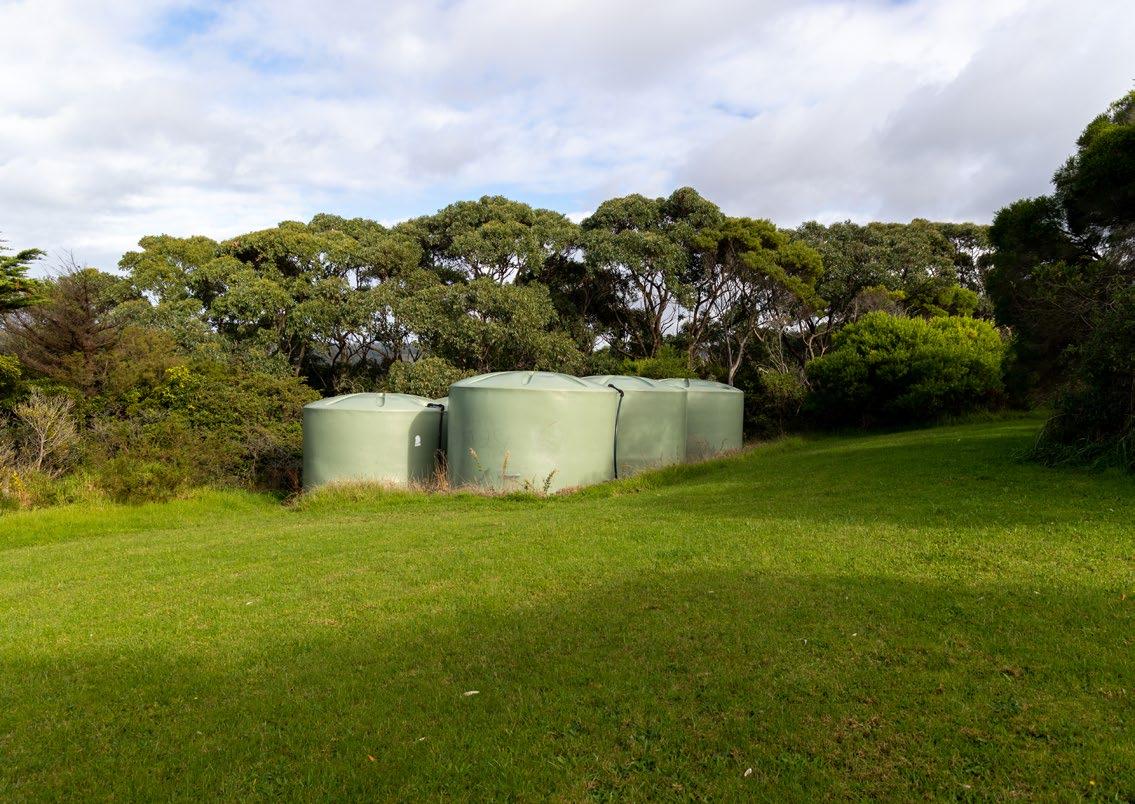

Apollo Bay Recreation Reserve Issues and Opportunities Paper Page 37
Water storage tanks
Pedestrian access to Gambier Street
Upper Reserve grassed area
Gambier Street boundary and fence
PONY CLUB PRECINCT
The Pony Club precinct is located on the eastern side of the Great Ocean Road, between the road and the Barham River, with approximately 200 metres of frontage to both the road and the river. The area is part of a sand spit and is approximately 1.2 hectares in size, which is mapped as being Land Subject to Inundation. Access to the facilities is via a small car park adjacent to the Barham River bridge.
The Apollo Bay and Otway Riding Club and Apollo Bay Pony Club have established a fenced riding paddock,




yards and pens for the loading and unloading of horses from the car park beside the bridge crossing the Barham River. The Club has no permanent buildings and uses a container to store equipment.
The fenced area includes areas of road reserve, Crown Reserve and public open space beside the river corridor. There is an exercise arena and two caravans used to store equipment. There are no permanent buildings on the site, with users required to cross the Great Ocean Road to access facilities including toilets.
Page 38 Apollo Bay Recreation Reserve Issues and Opportunities Paper
Yards near the car park
Yards and storage vans
Fenced riding area and old arena
Car parking and unloading area
FIRE SAFETY COMPLIANCE
The Authority is currently working to install additional water storage and fire safety pumps at the Reserve. This will include the installation of five 10,000 litre water storage tanks to meet current fire safety compliance requirements. Once the Masterplan is complete, a full fire safety upgrade can be undertaken and aligned to the Camping Uplift Project. The storage tanks can be relocated to Cape Otway or other locations if they are found to be surplus at the completion of the full safety upgrade.

INFLUENCING STRATEGIES LEGISLATION

INFLUENCING STRATEGIES AND LEGISLATION

There are a number of key strategies, legislative requirements and documents that will influence the development of the Masterplan. These include:
2018 GREAT OCEAN ROAD ACTION PLAN
The 2018 Great Ocean Road Action Plan committed the Victorian Government to creating a standalone Act of Parliament that recognises the Great Ocean Road region as a single, integrated and living entity. The Action Plan also commits to establishing the Authority as a statutory management authority, and for the Authority to adopt the following five objectives:
1. Protect the ecological and landscape integrity of coastal and marine environments
2. Increase Traditional Owner inclusion
3. Protect distinctive areas and landscapes
4. Grow the local, state and national visitation economy
5. Modernise governance
GREAT OCEAN ROAD ENVIRONS AND PROTECTION ACT 2020
The Authority was established under the Great Ocean Road Environs and Protection Act 2020 (part clause 46). Part 3 of the Act sets down protection principles that include general and economic principles, Aboriginal inclusion principles, environmental and social principles. Decision-making should be based on the effective integration of environmental, cultural, social and economic considerations.

Page 42 Apollo Bay Recreation Reserve Issues and Opportunities Paper
CROWN LAND (RESERVES) ACT 1978
This legislation ensures that Crown Reserves are responsibly managed and that natural resources such as water, flora and fauna, and scenic beauty are conserved while still encouraging public use and enjoyment of the land.
The Act governs the reservation of Crown land and provisions relating to the management, maintenance, and operation of Crown land.
CROWN LAND CARAVAN PARKS POLICY UPDATE 2019
This updates the Improving Equity of Access to Crown Land Caravan and Camping Parks, 2011. The update is relevant to the Reserve as it explains management processes related to annual permit sites, existing park residents, and itinerant worker accommodation permits.
Beginning on 1 October 2019, the new process requires existing long-term park occupants to be registered with the Department of Environment, Land, Water and Planning (now Department of Energy, Environment & Climate Action – DEECA), and enabled the Authority to issue accommodation permits to existing residents listed on the register.
Existing park residents have residency rights under the Residential Tenancies Act 1997, regardless of whether an accommodation permit has been granted. If an accommodation permit is not granted, the Authority must provide the minimum amount of notice to leave as required by the Residential Tenancies Act 1997 (generally 60 days).
The policy update sets out a similar process for committees of management (including the Authority) to offer temporary itinerant worker accommodation permits with written authorisation from DEECA. The duration of a temporary itinerant worker accommodation permit should align with the term of the workers’ employment, up to maximum of two years.
Apollo Bay Recreation Reserve Issues and Opportunities Paper Page 43
MARINE AND COASTAL ACT 2018
The Marine and Coastal Act 2018 (the Act) provides a simpler, more integrated and coordinated approach to planning and managing the marine and coastal environment by:
• Enabling protection of the coastline and the ability to address the long-term challenges of climate change, population growth and ageing coastal structures
• Ensuring that partners work together to achieve the best outcomes for Victoria’s marine and coastal environment.
The Act applies to all land between the outer limit of Victorian coastal waters and five kilometres inland of the high-water mark of the sea, unless otherwise excised by the Victorian State Government.
On 1 August 2018, the Victorian Government determined that the land “upstream of and including
MARINE AND COASTAL POLICY
This policy applies to the planning and management of matters relating to and affecting the marine and coastal environment. As defined in the Marine and Coastal Act 2018, the marine and coastal environment includes all private and public land and waters between the outer limit of Victorian coastal waters and five kilometres inland of the high-water mark of the sea.
the Great Ocean Road crossing of the Barham River, Apollo Bay, was land declared not to be Marine and Coastal Crown Land for the purpose of the Act.” In relation to the Reserve, it is interpreted that the Act only applies to the part of the Reserve east of the Great Ocean Road, currently occupied and used by the Apollo Bay Pony Club.
The implication is that the areas are now solely managed under the Crown Land (Reserves) Act and are not subject to coastal Crown land considerations. As such, the Reserve can be used for a more diverse range of uses than would be applied to foreshore Reserves that are subject to the Marine and Coastal Act. Current recreation activities on foreshore Reserves that do not meet the criteria under the Marine and Coastal Act may be considered for inclusion on the Apollo Bay Recreation Reserve.
A ‘Planning and Decision Pathway’ has been developed that sets out how the objectives and guiding principles of the Marine and Coastal Act 2018 are to be used in decision making for the marine and coastal environment. The ‘Planning and Decision Pathway’ aligns with the chapters of the Marine and Coastal Policy.
Page 44 Apollo Bay Recreation Reserve Issues and Opportunities Paper
MARINE AND COASTAL STRATEGY
This Strategy is a five-year action plan to begin implementing the Marine and Coastal Policy 2020. Delivery of this Strategy will allow Victorians to benefit from a healthy marine and coastal environment now and in the future.
The Strategy was developed with input from Traditional Owners, the Victorian Marine and Coastal Council, marine and coastal managers, communities, and interest groups.
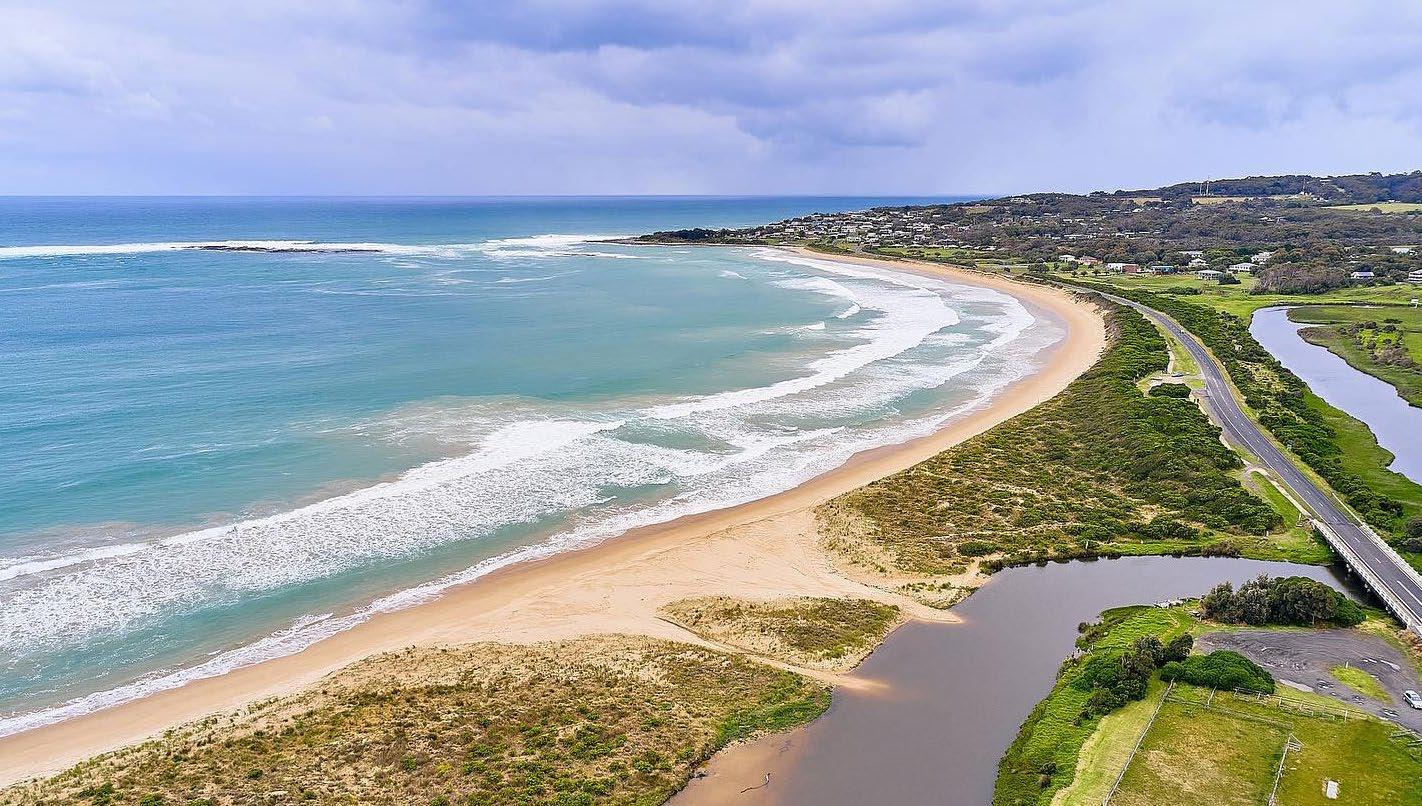
The Strategy includes six key actions shown below.
Action 1:
Traditional Owners determine how their rights and obligations are embedded into planning and management of the marine and coastal environment
Action 2: Improve the condition and ecological connectivity of habitats and respect and care for our marine and coastal areas
Action 3:
Adapting to impacts of climate change
Action 4:
Support sustainable use and development of the marine and coastal environment
Action 5: Implement the Marine Spatial Planning Framework
Action 6: Identify resource needs for sustainable marine and coastal management.
Apollo Bay Recreation Reserve Issues and Opportunities Paper Page 45


COMMUNITY INFRASTRUCTURE PLAN (CIP)
The CIP presents a long-term vision, principles, and preliminary concepts and ideas for Apollo Bay, Skenes Creek and Marengo for the purposes of community and stakeholder consultation. It was developed as a partnership project between Colac Otway Shire Council and the Authority. The CIP will be used to discuss and test the level of community and stakeholder support for a variety of concepts and ideas, and to understand local priorities.

For Apollo Bay, one of the key issues is the long-term future of the skate park located on the town foreshore. The foreshore site is subject to the Marine and Coastal Act 2018 (MACA) and the Marine and Coastal Policy 2020. Proposals for works or development in this area require MACA consent, including consideration of the Marine and Coastal Policy and whether the buildings have a functional need to be near the water. These legislative and policy directions have informed the findings in the CIP, which currently envisages the skatepark to remain in its existing location until it is considered unsafe or requires significant repair.
The Reserve is an option for the future location of this facility if it is to be relocated from the foreshore; however, further consultation is required to determine what other options are available.
Consultation with key stakeholders and the community was a key component of the CIP. The consultation included a three-stage process:
Consultation Phase 1:
To understand, discuss and confirm the existing opportunities and issues facing the project (including negotiables and non-negotiables).
Consultation Phase 2:
To inform the community of preliminary and emerging ideas and seek feedback about these ideas.
Consultation Phase 3:
To invite feedback from the various key stakeholders on the draft report and ensure there is support for the proposed CIP.
Page 48 Apollo Bay Recreation Reserve Issues and Opportunities Paper
COMMUNITY INFRASTRUCTURE ASSESSMENT
Prepared in 2021, in partnership with Colac Otway Shire (Council) and the Authority, the community infrastructure assessment provided an audit of existing community facilities and infrastructure. The assessment makes recommendations for future provision or consideration having regard to population trends, existing facility and infrastructure requirements, and stakeholder feedback. Best practice models to delivering active open space in the context of Apollo Bay are noted as:
• Active open spaces (e.g. sporting fields, tennis courts, netball courts, etc) should provide universal access and activities for a range of user groups (age, culture, ability, etc).
• Active open spaces require good connections to health and education facilities.
• Sharing of spaces with a range of community groups to enable good levels of utilisation.
For the Apollo Bay Recreation Reserve, the following recommendations were included (with Council to continue to work with relevant partner agencies to deliver these recommendations):
(A) Complete a Masterplan for the Reserve which allows for the upgrade of football, netball, cricket and tennis facilities to be fit for purpose.
(B) Investigate additional funding streams for the Reserve to provide additional facilities, changerooms, clubrooms etc.
(C) Prepare service agreements with Apollo Bay P-12 College to enable sporting facilities to be available after hours for use by the local community.
COLAC OTWAY SHIRE COUNCIL OPEN SPACE STRATEGY
The Colac Otway Shire Council Public Open Space Strategy (the Strategy) was prepared in 2011 to provide a strategic framework for the planning and provision of open space within the Shire.
The Strategy informs Council on the planning, provision, development, management, and protection of a diverse range of public open spaces to strengthen the attractiveness and liveability of the Shire and contribute to building healthier, more sustainable, and better-connected communities.
The Strategy notes the Reserve is the only public sporting place in Apollo Bay, and that while it provides good recreational opportunities for both visitors and
residents, there are few other useable open spaces in residential Apollo Bay.
In assessing criteria for open space provision and for planning future needs, the Strategy notes the catchment and distribution of useable open space in Apollo Bay to be within 400 metres of 95% of households.
The actions of the Strategy propose that the committee managing the Reserve (then Otway Coast Committee) minimise any impacts to the Reserve and open space in its Masterplan process and explore the provision of more sporting and other recreation opportunities for the local community.
Apollo Bay Recreation Reserve Issues and Opportunities Paper Page 49
CORANGAMITE REGIONAL FLOODPLAIN MANAGEMENT STRATEGY

2018-2028
This Strategy provides a single regional planning document for floodplain management and a regional work program to guide future investment priorities. The Strategy focuses on flooding associated with river systems (riverine flooding) and coastal storm surge inundation, including planning for a projected sea level rise. With regards to climate change in the Corangamite region, the Strategy notes an increase in severe weather events, with less rainfall but more intense rainfall events. Projections are for sea levels to rise and for there to be an increase in extreme natural events such as floods. Apollo Bay is identified as a priority risk area in the regional risk assessment, with flood risks associated with the Barham River to the west of town.
Page 50 Apollo Bay Recreation Reserve Issues and Opportunities Paper
A flooded section of the Reserve
BIODIVERSITY ASSESSMENT
In June 2022, an environmental assessment of the Apollo Bay Recreation Reserve was undertaken by Beacon Ecological to inform the Masterplan. The study identified the ecological features of the area (see the image on the next page for reference) in relation to both flora and fauna, including native vegetation and koala habitat. The Reserve is identified in local planning controls as being located within the Environmental Significance Overlay – Lakes, Wetlands and Watercourses providing an environmental resource important for stream habitat and minimising erosion.
Any proposed works or removal of native vegetation will require approval in accordance with the planning framework administered by Colac Otway Shire Council. Although the study concluded “that it is considered unlikely that any proposed works will have a significant impact on any matters of national environmental significance”(namely listed threatened species and ecological communities), there are localised actions that can be undertaken to drive ecological health and integrity outcomes.

Apollo Bay Recreation Reserve Issues and Opportunities Paper Page 51
EMERGENCY MANAGEMENT PLAN (EMP)
The Emergency Management Plan (EMP) adopts the Mitigation, Planning, Preparedness, Response and Recovery (MPPRR) approach to emergency management, ensuring alignment with AS 3745. While most of the detail is centred around operational matters, there are design considerations including access, firefighting infrastructure, and bushfire prevention to be included within the recommended Masterplan for the Reserve.
The Masterplan will need to ensure that people are able to exit the site during any emergency. The Masterplan will also include the required location of fire hose reels and/or hydrants for the park operators and local fire authorities to access when required.
COMMERCIAL REVIEW
The Authority generates revenue in a way that is equitable and ensures it is re-invested responsibly to make the Great Ocean Road and its many attributes available to current and future generations. Our objective is to do so taking a quadruple bottom line approach, recognising the importance of the environment, community and culture, alongside financial performance. To ascertain demand for the provision of camping facilities year-round, a high-level analysis of the revenue generated each month was undertaken by lead consultants Integrated Site Design with the following observations:
• Of the total tourist revenue (excluding annual permit sites and cabins), 90% is generated between the months of November and April.
• Casual powered sites earn approximately the same revenue during the period November to April as the annual permit sites earn over 12 months.
• Cabin revenue is currently low as some are being used to accommodate Authority workers, which will continue indefinitely. It should be noted that the cabins are in poor condition and not suitable for tourists.
• The seasonal sites on the oval perimeter are only required during the summer holiday period as there is sufficient vacancy on other unpowered sites at other times of the year. The seasonal sites will possibly be required over Easter as well, but this may clash with sporting events.
• There is potential to increase the occupancy of the sites with improved facilities and better presentation of the camping precinct.
The Authority has advised that the restriction of camping to a specific season will result in reduced operating expenses and will have minimal impact on the financial returns of the campground.
Page 52 Apollo Bay Recreation Reserve Issues and Opportunities Paper
COLAC OTWAY PLANNING SCHEME
The planning scheme identifies the requirements and considerations that apply to the development of land within the Colac Otway Shire. The scheme includes overlays which identify the areas of the land that are impacted by specific constraints.
The land occupied by the Reserve is subject to three overlays shown below. Each of these overlays impact specific areas of the Reserve and require

any application for development proposals to be cognisant of their specific triggers and respond to the requirements of these overlays.
For example, buildings used for accommodation on land within the Land Subject to Inundation Overlay are required to have a floor level at a minimum height to avoid future water inundation during weather events.
Apollo Bay Recreation Reserve Issues and Opportunities Paper Page 53 Environmental Significance Overlay Erosion Management Overlay Land Subject to Inundation Overlay
ISSUES OPPORTUNITIES
The legislation, planning frameworks, existing strategies and consultation to date identify several opportunities to be explored and issues to be considered as part of the Masterplan process.
The many stakeholders who contributed to the community engagement phase and the diverse range of views heard should be acknowledged. It is clear the Reserve is valued and used by different community and sporting groups for a range of purposes (sport and recreation, tourist and worker accommodation, community events). This creates challenges around competing use of space and facilities.

This challenge is coupled with significant constraints affecting the use of the site, including topography, biodiversity and ecological values, and risk from riverine and coastal flooding.
The context of competing uses occurring within a constrained site calls for a genuine acknowledgement that not all current uses can or should be supported into the future. The Masterplan process provides the
opportunity to consider future land use and activities that can best adapt or avoid flood risk, and which can continue without detriment to the site’s ecological values.
It is also important to restate the overarching legislation and policy objectives relating to Crown land caravan parks. Crown land is set aside for public enjoyment by all Victorians. The Authority has a responsibility to manage camping and visitor accommodation at the Reserve to provide equitable access for new and regular visitors.
ISSUES AND OPPORTUNITIES
Future funding and implementation
The site has experienced underinvestment over recent years, with assets generally aged and requiring significant upgrade or replacement. The implementation of the Masterplan will require funding from a range of partners including other levels of government, to put recommendations into action.
It must be acknowledged that successful implementation of the Masterplan will require the detailed design of major elements including the sporting pavilion as well as significant funding from a range of partners including other levels of government and agencies to put recommendations into action.
While the land upon which the Reserve is located is now managed by the Authority, it should be noted that historically the Otway Coast Committee has been responsible for managing and maintaining sport and recreation facilities, with Colac Otway Shire Council contributing an operational grant to assist with maintenance.

ISSUES
There are several issues affecting the Reserve that constrain its current operation, as well as hinder opportunities to make better use of the Reserve as Apollo Bay’s only public sport and community recreation facility.
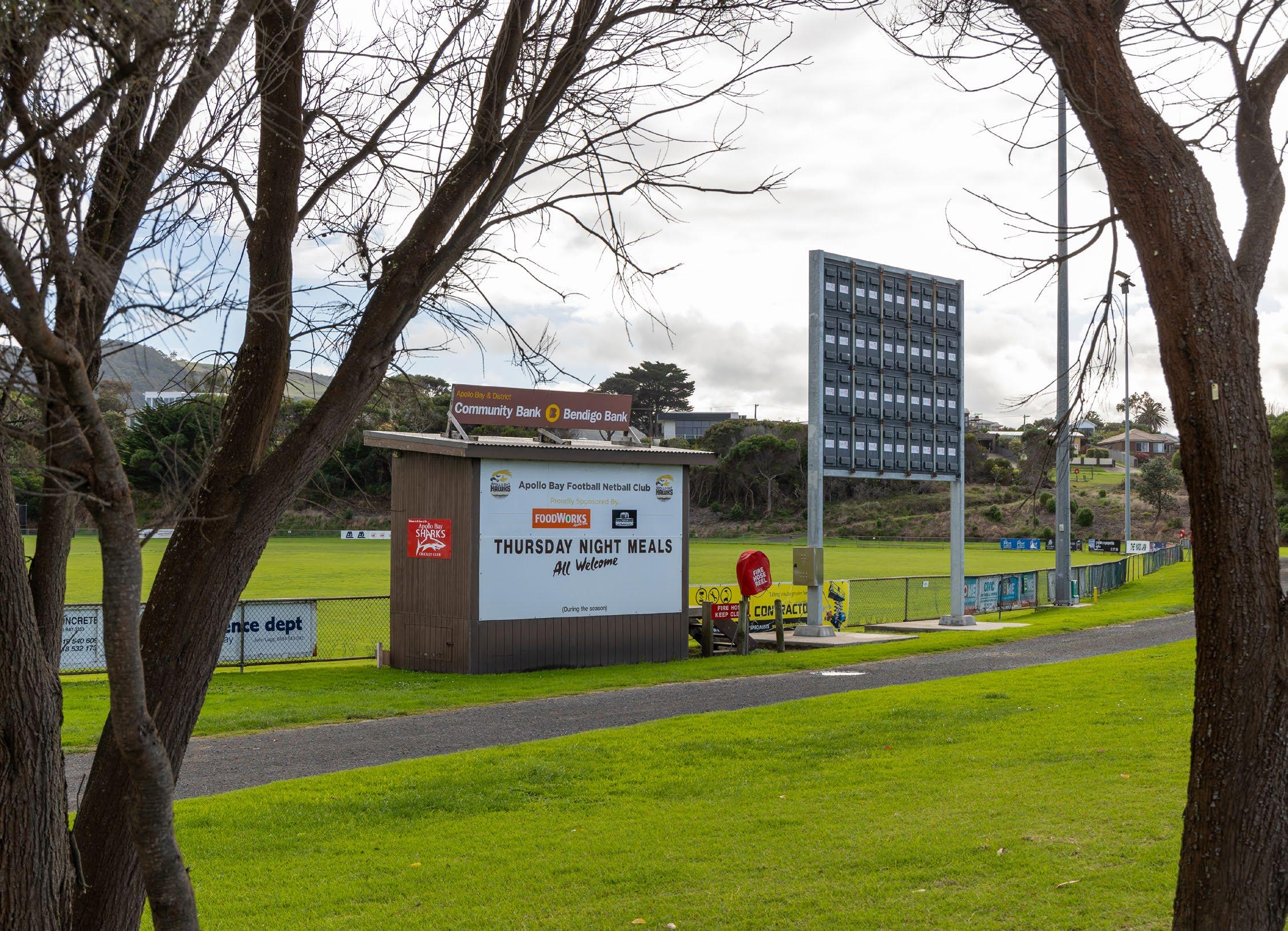
Of particular note, the flood risk information provided by the Corangamite Catchment Management Authority, has implications on fixed accommodation structures in low lying areas.
Issues discussed in this section include:
• Riverine flooding risk
• Coastal flooding risk through future sea level
• Fixed accommodation structures, annual permits, equity, compliance, risk, and safety
• Sporting and recreational use
• Parking
• The Pony Club site
• Storage for other user groups
Page 56 Apollo Bay Recreation Reserve Issues and Opportunities Paper
RIVERINE FLOODING RISK
The Reserve is subject to flooding from the Barham River and is mapped as Land Subject to Inundation Overlay in the Colac Otway Planning Scheme. The map above indicates the projected depth of a 1% Annual Exceedance Probability (AEP) riverine flood coinciding with a 10% AEP storm tide event based on 2030 and 2100 climatic conditions. The AEP refers to the probability each year of a certain size flood being equalled or exceeded. This reinforces there is

an ongoing flood risk every year, regardless of how recently there was a similar flood.
The site will also be affected by coastal hazards including sea level rise and storm surge inundation associated with a changing climate. The combination of predicted tides and storm events (storm surge) can result in temporary inundation of areas previously unaffected by flooding.

Apollo Bay Recreation Reserve Issues and Opportunities Paper Page 57
Subject property showing the 1% AEP riverine flood depth mapping coinciding with a 10% AEP storm tide event based on 2030 climatic conditions on the left, and 2100 climatic conditions on the right
RIVERINE AND COASTAL HAZARD RISK MANAGEMENT –NOW AND IN THE FUTURE
Appropriate site planning needs to consider, accommodate, and where possible avoid the risk posed by riverine flooding and coastal hazards. This can include designing buildings to reduce exposure to flooding, or decrease the impact of flooding; and an appropriate adaptation option to enable the continued use of the site in the medium-term.
All proposed buildings for example will be required to have a floor clearance of 300 millimetres above the projected flood level. Most existing structures at the Reserve have been constructed at ground level and therefore are subject to inundation.
The Masterplan will also need to consider access and requirements for emergency management in response to flood events. The single sealed access point from the Reserve onto the Great Ocean Road is a significant constraint and concern in the event of evacuation or emergency flood response at the site.
As the frequency and intensity of these hazards are expected to increase due to the impacts of climate change, there will be an increased risk to human safety,
buildings, and infrastructure. Decisions will need to be made about the continued suitability of the site for accommodation and recreation activities over the longer-term.
These decisions should be informed by scientific data and monitoring of climate change impacts. The following will help make informed decisions:
• Updating the 2019 flood modelling of the Barham River. The Authority is advocating for up-to-date modelling specific to this region and will work with key stakeholders to actualise this objective.

• Develop the Authority’s coast-wide ‘Coastal Vulnerability and Adaptation Plan’ which will align with the Victorian Resilient Coast – adapting for 2100+ guidelines.
New modelling and information may influence planning scheme conditions and the site’s risk profile over the course of the Masterplan implementation, meaning that land use and future buildings will need to consider and continue to respond to changing flood risk scenarios.
Page 58 Apollo Bay Recreation Reserve Issues and Opportunities Paper
The Barham River
ANNUAL PERMIT SITES AND FIXED ACCOMMODATION –COMPLIANCE, RISK AND SAFETY, AND EQUITY
There are several issues affecting the annual permit sites, which together lead to the view that this type of accommodation is not an appropriate fit for the Reserve.
CONDITIONS AND COMPLIANCE ISSUES
Historically, annual permit sites were created to improve revenue from sites which had low occupancy, particularly in the cooler months. The annual permit allowed a permit-holder to place their caravan on a dedicated site for a set annual fee for a 12 month period. Occupants can apply to renew the permit at the end of each 12 months; however it is important to note that a annual permit is not a guarantee for access to that site in subsequent years.

It is a condition of an annual permit that the site is to be used for a maximum of 59 consecutive nights and a total of 180 days per calendar year. Permits also include design and construction requirements regarding annexes and decking.
At the end of the annual period, the caravan and any annexe or attachments must be capable of being removed from the site.
The existing annual permit holders at the Reserve have
been onsite for many years and in some cases have built extensions, fixtures and permanent structures that contravene permit conditions.
The Authority understands that many annexes and other built extensions do not have floor levels compliant with the minimum flood level requirements and there is a risk of damage to private property (e.g. furniture and vehicles).
Further, the intermittent occupancy and varying number of visitors using the annual permit sites at any one time makes it difficult to clearly determine how many visitors are present at the Reserve. This can cause uncertainty for emergency management services and complicate evacuation procedures in the event of flooding.
The need to respond to natural hazards and impacts of climate change are not limited to Apollo Bay. Land managers in Victoria will need to reassess the suitability of visitor accommodation in coastal and riverine areas in response to climate change risks.
This is increasingly a national issue with many caravan parks and campgrounds affected by recent flooding in Queensland and New South Wales.
Apollo Bay Recreation Reserve Issues and Opportunities Paper Page 59
Existing structures built by annual permit holders
OTHER FIXED ACCOMMODATION
The policy framework and flooding risks affecting the Reserve also mean the site is not suitable for permanent housing. Any new fixed accommodation should be relocatable, temporary structures that are capable of being moved. As noted previously, all accommodation will be subject to regular review pending flood and inundation risk assessments.

POLICY CONSIDERATIONS – EQUITY AND FAIRNESS
Crown land is a public resource and cannot be owned by an individual. The purpose of Crown land caravan parks is to provide Victorians access to short term, affordable holidays. The Authority is the Crown land
manager for the Reserve and has obligations to manage annual permits consistent with state policy, including:
• Implementing policies that balance respect for regular campers with the rights of newer campers to have fair and reasonable access to Crown land parks
• Protecting the Reserve from any sense of longterm occupancy.
The Authority acknowledges the shift to discontinue annual permit sites is a significant change and may be stressful for visitors who have been coming for a long time. The Authority will continue to work with permit holders through this process.
Page 60 Apollo Bay Recreation Reserve Issues and Opportunities Paper
Existing cabins
SUPPORTING EXISTING REGISTERED RESIDENTS
There are three registered residents at the Reserve. These long-term occupants were transferred to twoyear accommodation permits in accordance with the process set out in the Crown Land Caravan Parks Policy Update 2019.
As detailed in this Paper, the risks from coastal hazards and flooding mean the site is unsuitable for long- term or permanent residential use. Management guidelines for Crown land caravan parks also disallow the use of parks for permanent residents.
There are five cabins at the Reserve that are currently used for Authority staff accommodation. Three of these cabins could be used to house the registered
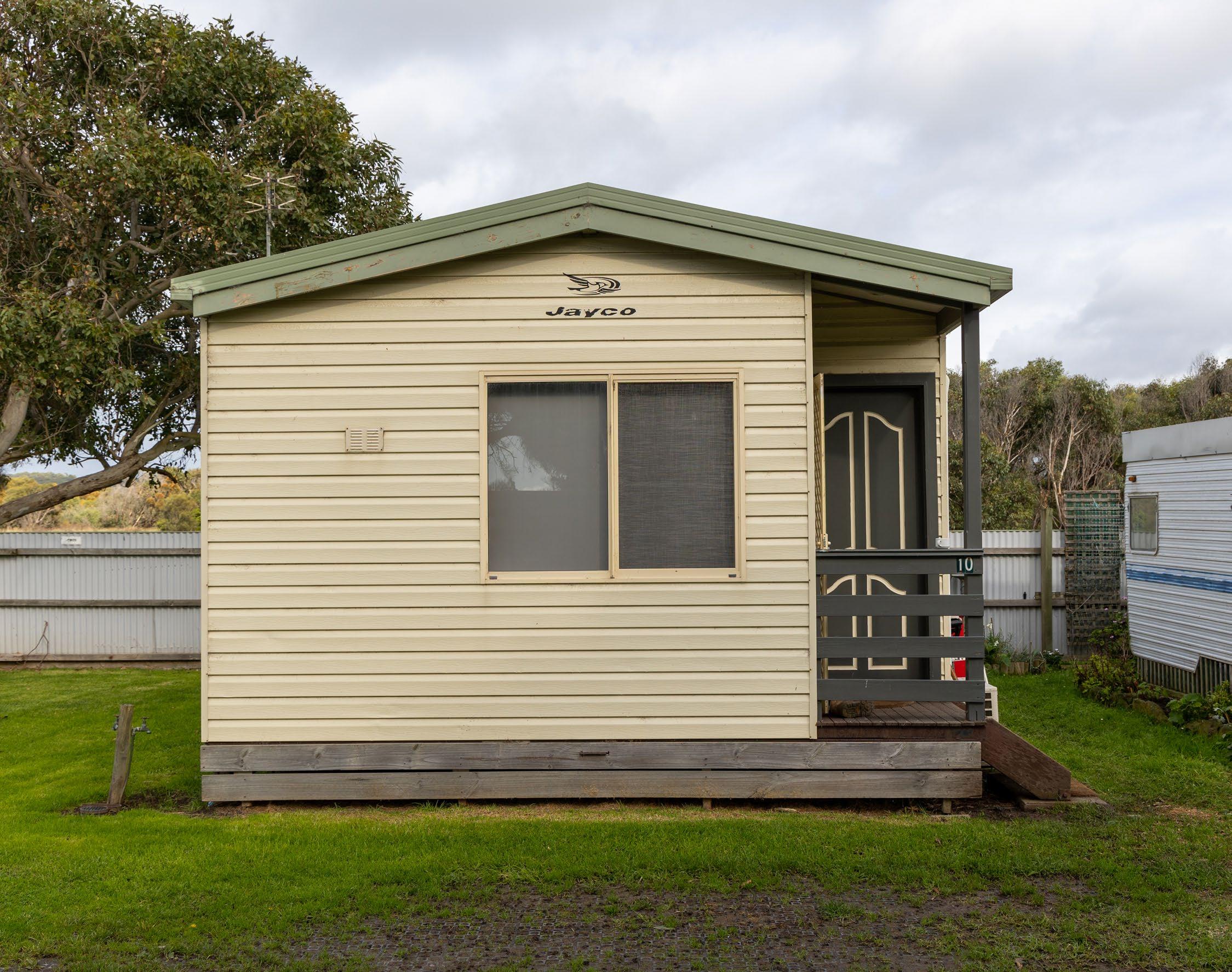
residents as an interim step until long-term, secure housing can be found. The Authority should support the residents through this transition process as much as possible, such as connecting residents with available resources and support services.
The three registered residents should be exempt from any process relating to the removal of annual permit holders as outlined in the Issues section of this Paper. The Authority should continue to engage with the three registered residents and negotiate the terms of their existing accommodation permits considering their personal circumstances.
Apollo Bay Recreation Reserve Issues and Opportunities Paper Page 61
An existing cabin
SPORTING AND RECREATIONAL USE
The Reserve’s sporting clubs have highlighted several issues that need to be addressed as part of the Masterplan. While the current commercial kitchen and bar are functional to the needs of the clubs, the design of the clubroom does not cater for the needs of the various user groups, in particular female participants. The facilities are inadequate, the amenities and changerooms are in poor condition and are shared with campground visitors.
The netball and tennis courts need to be upgraded and modified to bring them in line with current standards. The cricket club nets need major maintenance, and one additional net is required to comply with standards.
There are no formal agreements in place for users of the sporting facilities. Currently, this is dependent on individuals of the respective sporting clubs. Formal agreements ensure that all parties know their roles and responsibilities in the management of the Reserve and facilities. This ensures that there is a process in place should there be a change in personnel within the clubs or the Authority. The existing clubhouse
buildings are located within the flood overlay (Land Subject to Inundation). New buildings and works in this location will require planning approval from Colac Otway Shire and be subject to minimum floor level requirements stipulated by the Corangamite Catchment Management Authority.
FUTURE SPORTING FACILITY MANAGEMENT
The Reserve is currently managed and maintained by the Authority, with Colac Otway Shire making a small financial contribution towards the maintenance of public sporting facilities.

This Paper has identified the need for investment in assets to support the sporting groups and local community and to upgrade the campground.
Implementation actions stemming from the Masterplan should seek to formalise a joint approach by the Authority, Colac Otway Shire Council, and other levels of government, along with clubs and community organisations to secure funding for the upgrades. As a future action, Council and the Authority, in partnership with the community, will need to determine their priorities for project delivery.
Page 62 Apollo Bay Recreation Reserve Issues and Opportunities Paper
CAR PARKING
Representatives of the Apollo Bay Football Netball Club and the Agricultural Show Society stressed the need to maintain or increase the level of car parking available at the Reserve. With the increasing number of students attending the local school, the number of sporting participants is expected to grow over future years, therefore the Masterplan must cater for an expansion of facilities and parking. A traffic assessment will be required to inform the Masterplan in relation to the future provision of car parking.
The Pony Club site is also used for overflow parking during certain events, however, crossing the Great Ocean Road is a major issue.
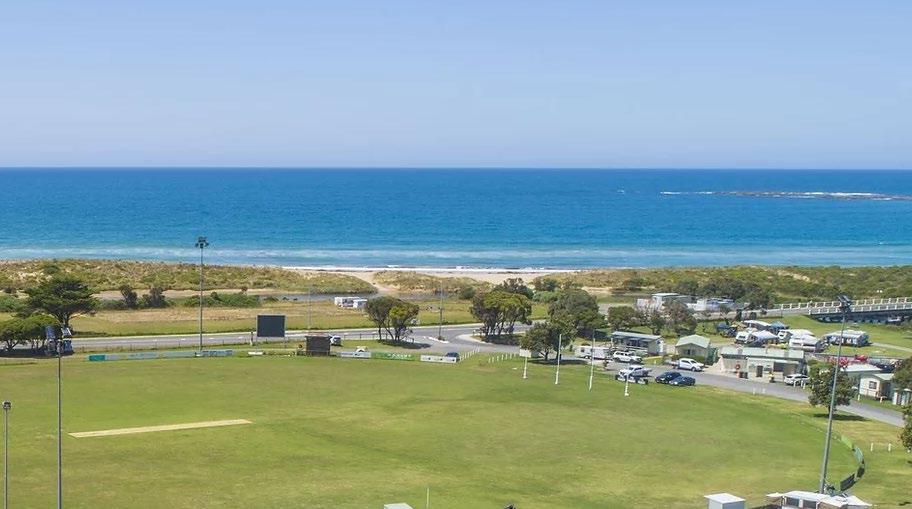
INDUSTRIAL HALL
The Industrial Hall is located within the Land Subject to Inundation Overlay and is affected by riverine flooding. The existing use of the hall for storage could continue in the short-to-medium term, subject to structural and safety audits. In the longer term, the building may need to be modified, or replaced by a new building capable of withstanding flood and coastal hazards.
Apollo Bay Recreation Reserve Issues and Opportunities Paper Page 63
The main oval overlooking Mounts Bay
PONY CLUB SITE
The Pony Club occupies an area on the coast side of the Great Ocean Road, which separates the club from the main part of the Reserve. The Pony Club site occupies several land parcels and is subject to multiple land managers.

The majority of the site is located within the Great Ocean Road Reserve and is managed by Transport for Victoria (Department of Transport and Planning). The remainder of the site, including public open space along the Barham River, is coastal Crown land managed by the Authority.
The land is zoned PCRZ (Public Conservation and Resource Zone), and the entirety of the site remains subject to the provisions of the Marine and Coastal Act 2018 (the Act) and Marine and Coastal Policy 2020 (the Policy)
The findings from community engagement highlighted the importance of the Pony Club to the Apollo Bay Agricultural Show by providing space for horses to be corralled, storage for show equipment, and accommodation for participants. There are no permanent buildings or infrastructure on the site
associated with the Pony Club (other than two temporary/moveable caravans).
The Pony Club’s tenure agreement has lapsed and is currently under review by the Authority. Given the value of the Pony Club site to the Agriculture Show and broader community, consideration should be given to retaining the club onsite until an appropriate alternative location is found. This could be done through a short-term tenure arrangement between the club and the Authority.
Potential site uses following the relocation of the Pony Club include overflow carparking for sport or community events. The existing car park could also be improved to provide better access to the river or walking trails.
In the longer term, the use of the site should be aligned with the principles and objectives for coastal Crown land as set out in the Act and the Policy. This could include improving the ecological health of the site by returning the area to passive public open space and improving the extent of riparian vegetation along the Barham River.
Page 64 Apollo Bay Recreation Reserve Issues and Opportunities Paper
STORAGE FOR OTHER USER GROUPS
The Apollo Bay Sailing Club has identified the need for storage space for their safety boats. The boats are currently stored on private land, which does not offer a long-term solution.
The lack of public space to service community needs should not result in the activation of this site as a storage facility.
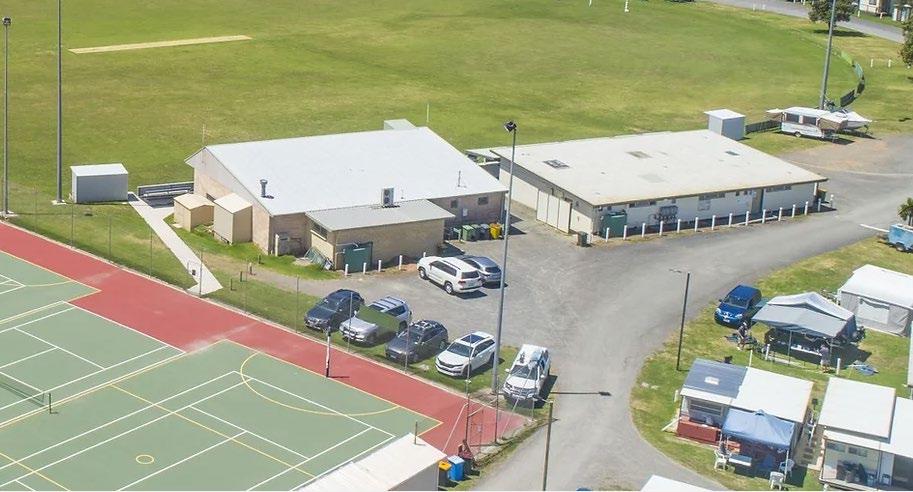
Apollo Bay Recreation Reserve Issues and Opportunities Paper Page 65
The Reserve’s sporting facilities
OPPORTUNITIES
With the Reserve offering limited area to service a growing demand from multiple users, the Masterplan considers options that respond to these demands by providing multi-functional and flexible spaces and facilities.
Reconfiguring the Reserve seeks to better balance sports, camping, community activities and open space, including access to barbecues, picnic areas, and playground facilities.
This reconfiguration provides an opportunity to design a layout of the Reserve that achieves optimal use of the land, ensuring access and parking to all sporting facilities and placing communal facilities in the most appropriate location. It also aligns with equitable access requirements specific to the activation and use of Crown land.
A reconfiguration would consider the removal of fixed cabins, fixed caravans and annexes (constructed by annual permit holders).
The following opportunities have been identified:
• Expanded sporting facility area
• Public use and amenity
• Additional area for community event use
• Campground redesign that addresses riverine and coastal flooding risk
• Expanding the range of accommodation options
• Revegetation and weed control and promoting the ecological and cultural heritage importance.
Page 66 Apollo Bay Recreation Reserve Issues and Opportunities Paper
SPORTING FACILITIES EXPANDED TO MEET CURRENT AND FUTURE REQUIREMENTS
One of the key opportunities for the Masterplan is to achieve compliant sporting facilities at the only recreation Reserve located within the Apollo Bay, Marengo and Skenes Creek area. This Reserve provides significant sporting infrastructure for the residents and visitors to the area for formal sporting activities including football, cricket, netball and tennis.
The construction of a new or modified clubrooms, catering for all sporting groups and meeting accessibility requirements, will provide a long-term solution to address the inadequate facilities. A sketch design, shown above, has been developed by football and netball club members, providing changerooms for all sports and a social room and kitchen to cater for sporting or social functions.

This design demonstrates what could be located at the Reserve, subject to detailed design and may not represent any final determination in relation to this matter.
The tennis and netball courts and the cricket nets could potentially be expanded to comply with current sporting standards.
The consideration of seasonal camping and removal of the majority of fixed cabin/caravan sites also provides the additional recreation space for teams to warm up or practice when the main oval is being used.
Apollo Bay Recreation Reserve Issues and Opportunities Paper Page 67
A sketch design of the proposed clubrooms by the football and netball club
PUBLIC USE AND AMENITY
There is an opportunity to improve public access and use of the river edge with a focus on a seasonal camping option. Shared accessways along the river corridor would establish connections along the length of the foreshore, and seasonal (summer) use of camping areas would add capacity and facilitate broad public access during off-peak seasons.
The provision of a public open space ‘hub’ around the new camp kitchen and toilet facilities would create a permanent gathering point suitable for a range of community events and activities. Visual access from the main sporting and recreation facilities to the river foreshore would also be improved through removal of some infrastructure.
Subject to a detailed engineering assessment, the timber bridge located on the western boundary (currently closed to pedestrians) could provide an opportunity for a viewing platform, potentially including interpretive or educational signage about the local environmental values. This opportunity should be explored if the bridge is structurally sound or can be remediated with minimal cost. The bridge is an asset belonging to Colac Otway Shire Council, requiring consultation with Council before proceeding with any further investigations.
ADDITIONAL AREAS FOR COMMUNITY EVENTS AND ACTIVITIES
An opportunity could be created for additional events to be held at the Reserve.
Seasonal camping could also provide more space for parking during the off season to support the sporting clubs or any events held at the Reserve.
The Apollo Bay Agricultural Show (last held in March 2023) is a major community event at the Reserve and requires the use of land that is occupied by the Pony Club. Introducing seasonal camping could provide additional space to permit activities such as
the Agriculture Show to be hosted on the Reserve as opposed to the Pony Club site.
There is an opportunity to retain and repurpose the Industrial Hall building for community use. The scope could include its use as an interpretation centre for local fossils or information on local environmental values. In this purpose, the building could be utilised by local environment groups as a space to engage with the community. This would complement the nearby Apollo Bay Museum which is at capacity.
Page 68 Apollo Bay Recreation Reserve Issues and Opportunities Paper
CAMPGROUND REDESIGN
A transition to seasonal camping (November to April) is supported by a commercial review of the caravan park prepared by Integrated Site Design (refer to the graph below). The review noted the highest occupancy rates occur during summer period.
This transition would help free up space for sports events, especially around the months of May to October. If a commercial shift is adopted in the draft Masterplan, any outcome will be informed by the Authority’s Caravan and Camping Optimisation Plan which is currently in development.
A shift to seasonal camping could be integrated with a redesign of the campground layout to relocate significant campsite facilities which require investment
to avoid or minimise risks from riverine and coastal flooding. This could include positioning facilities on higher ground and raising floor levels for new amenities buildings and camp kitchen.

Apollo Bay Recreation Reserve Issues and Opportunities Paper Page 69
APOLLO BAY RECREATION RESERVE CARAVAN PARK OCCUPANCY 2021-22 100 Powered site Unpowered site Unpowered oval site Unpowered river site 60 80 40 20 Jul21Aug21Sep21Oct21Nov21 Dec21 Jan22 Feb22Mar22 Apr22May22Jun22
EXPANDING THE RANGE OF VISITOR ACCOMMODATION
There is an opportunity to offer a wider range of camping accommodation at the Reserve to attract a more diverse group of visitors.
The Authority has received grant funding for the installation of ten accessible (Disability Discrimination Act - DDA compliant) camping tents, and ten high-end ‘glamping’ tents.

The proposed tents provide a more flexible and temporary form of accommodation, with capability to be located and installed to avoid flood risk. A defined visitor season and booking system will provide clear information about the number of visitors onsite, thereby assisting emergency management and reducing the level of risk to visitors.
The Masterplan process will determine the best location for the new tents, taking into account access to amenities, camp kitchen, impacts to surrounding residents, and flood risk.
IMPROVED ACCESS AND EQUITY
Retaining traditional visitor camping (powered and unpowered sites) and expanding the accommodation offer with new glamping tents will help to achieve broader policy and management objectives (refer to Crown Land Caravan Parks Policy Update 2019 at Section 4.1.3).
SEASONAL WORKER ACCOMMODATION
Through consultation with the Apollo Bay Chamber of Commerce, the lack of accommodation available for seasonal workers during peak periods was highlighted as a priority. As with many regional areas in Australia, Apollo Bay has a shortage of affordable seasonal worker accommodation.
In response to the lack of seasonal worker accommodation, Colac Otway Shire Council introduced a Temporary Worker accommodation permit in 2021. The permit provides an opportunity for local businesses to sponsor an employee to camp at a location with existing amenities for their period of employment between 1 November and 30 April inclusive each summer season.
Policy relating to coastal Crown land and risk from flooding make the Reserve unsuitable for permanent housing. There is, however, the opportunity to provide seasonal accommodation within elevated areas of the Reserve less susceptible to flooding. This could include a mix of visitor and seasonal worker accommodation subject to further analysis in partnership with the Council. All accommodation would be subject to regular review pending flood and inundation risk assessments.
Page 70 Apollo Bay Recreation Reserve Issues and Opportunities Paper
DDA compliant camping tents
CAMP AMENITIES REDESIGN
Following the receipt of grant funding in 2022 which had a number of deliverables, the Authority commenced a process to upgrade the camp amenity blocks and to construct a new camp kitchen area. This process was put on hold to align design and future works with the draft Masterplan.

An opportunity exists to design new amenity buildings and a camp kitchen to provide a flood resilient and allweather facility that provides a high amenity outcome to users.

Consistent with the deliverables of the previous proposed upgraded amenities, the new amenities will be designed to meet regulation requirements in relation to the number and location of facilities, and accessibility. In addition, the new amenities will be designed to ensure the floor heights are above flood level, whereas the existing amenities are located at ground level. The design will also include laundry facilities in accordance with the regulations. The portable nature of the buildings will additionally allow the facilities to be removed should future climate change projects require the Authority to vacate from the site to manage risks.
Currently, campers share the changeroom facilities with sporting groups. This issue has been raised by the sporting groups as sports participants may be changing at the same time a guest of the caravan park is using the facility. The correct and appropriate location of amenities will remove the need for campers to use sporting club facilities.
There is an opportunity for the camp kitchen to be designed so that it is able to be fully open during periods of fine weather or fully closed during poor weather. The camp kitchen will have indoor cooking facilities, including barbecues and hotplates. This facility will be an enormous asset for tourists during the peak seasons, and to the community to complement both passive and active recreation.
Apollo Bay Recreation Reserve Issues and Opportunities Paper Page 71
Relocatable amenities
Revised camp kitchen
ECOLOGICAL AND CULTURAL HERITAGE IMPORTANCE
The Authority can accommodate the protection of any cultural heritage through improved design of the site. Opportunities to augment the current ecological values include:
• Remove and manage weed species (especially within the riparian zone of the Barham River), including the regionally controlled noxious weeds within the Corangamite CMA: blackberry and ragwort
• Infill removed weed species with native vegetation (ground covers, shrubs, and trees) suppressing new weeds and providing additional habitat value
• Avoid the removal of native vegetation, and if necessary, native trees should be trimmed rather than removed
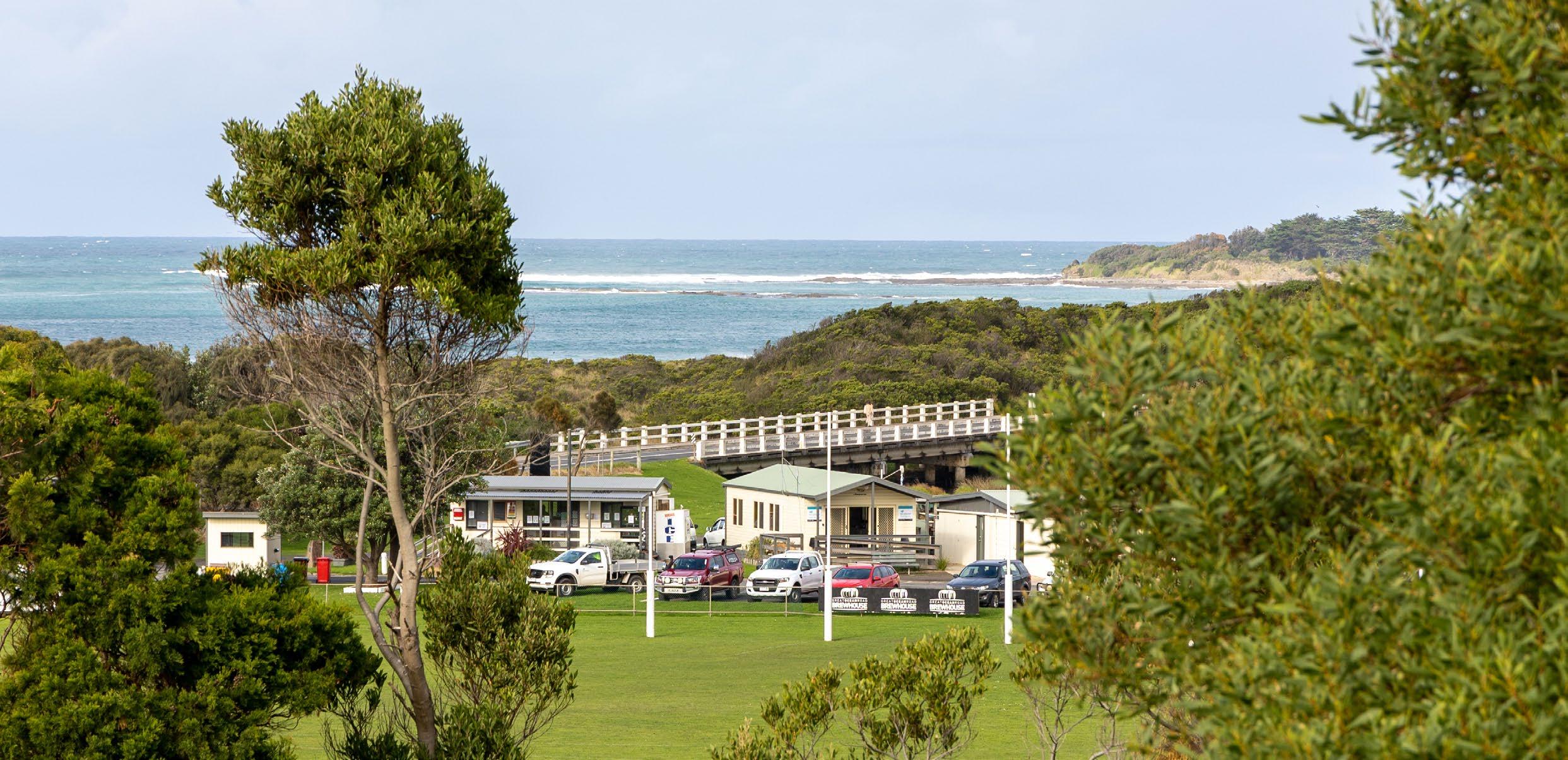
• Revegetate a suite of native vegetation consistent with the identified EVCs (EVC 16 Lowland Forest and EVC 53 Swamp Scrub) to improve the Vegetation Quality Assessment scores within the Reserve
• Seek to work with Southern Otway Landcare Network and Eastern Maar Aboriginal Corporation
Traditional Owners to plant locally providence and raised species
• Manage and conserve existing older native trees as these provide nesting, perching, hunting and foraging sites for a range of native fauna
• Additional native trees should be planted for native fauna habitat, shade trees for camp users and for their aesthetic value
There is an opportunity for the Authority to begin a discussion with Eastern Maar regarding reinstatement of traditional place names at the Reserve, conservation objectives and opportunities to enhance storytelling in built infrastructure. The Authority will be undertaking a voluntary Cultural Heritage Management Plan to help direct and manage the protection and enhancement of cultural values at the Reserve. Although this plan identifies our statutory obligations under the Aboriginal Heritage Act, the Authority will work in partnership with Traditional Owners to recognise and respect their assertions over the protection of their tangible and intangible values. The Authority will work from a first principle of no cultural heritage damage.
Page 72 Apollo Bay Recreation Reserve Issues and Opportunities Paper
CONCLUSION AND NEXT STEPS
The options and directions articulated through the Paper are designed to be tested through Council, stakeholders, and community engagement to inform the further stages of the project.
It is noted that the concepts identified have been developed to highlight potential key directions and ideas in the early stages. These are not final and are still to be tested through consultation, design refinement and in response to further site investigations, as required.



































 BBQ shelter
Clubroom and changeroom parking
Tennis clubhouse Cricket nets
BBQ shelter
Clubroom and changeroom parking
Tennis clubhouse Cricket nets











































